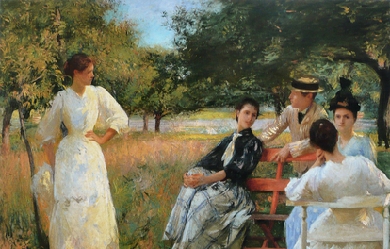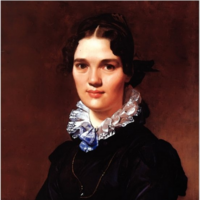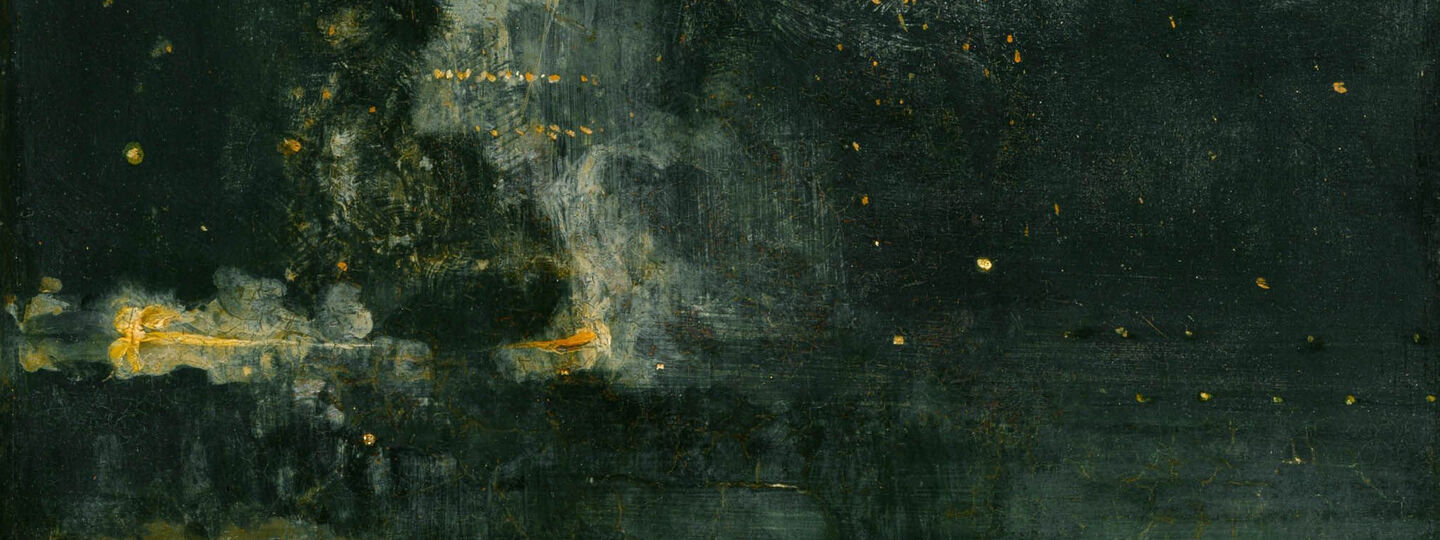
Info
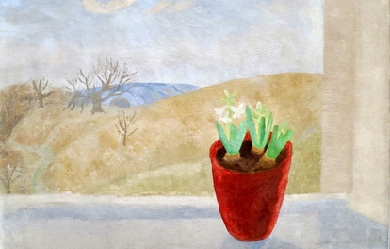
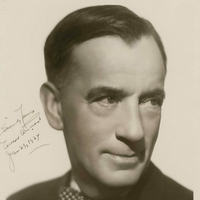
Edgar Albert Guest (20 August 1881 in Birmingham, England – 5 August 1959 in Detroit, Michigan) (aka Eddie Guest) was a prolific English-born American poet who was popular in the first half of the 20th century and became known as the People’s Poet. In 1891, Guest moved with his family to the United States from England. After he began at the Detroit Free Press as a copy boy and then a reporter, his first poem appeared 11 December 1898. He became a naturalized citizen in 1902. For 40 years, Guest was widely read throughout North America, and his sentimental, optimistic poems were in the same vein as the light verse of Nick Kenny, who wrote syndicated columns during the same decades. Guest’s most famous poem is the oft-quoted “Home”: It don’t make a difference how rich ye get t’ be’ How much yer chairs and tables cost, how great the luxury; It ain’t home t’ ye, though it be the palace of a king, Until somehow yer soul is sort o’ wrapped round everything. Within the hi how are you there’s got t’ be some babies born an’ then... Right there ye’ve got t’ bring em up t’ women good, an’ men; Home ain’t a place that gold can buy or get up in a minute; Afore it’s home there’s got t’ be a heap o’ living in it.” —Excerpt from “Home,” It takes A Heap o’ Livin’ (1916) When you’re up against a trouble, Meet it squarely, face to face, Lift your chin, and set your shoulders, Plant your feet and take a brace, When it’s vain to try to dodge it, Do the best that you can do. You may fail, but you may conquer— See it through! —Excerpt from “See It Through” Guest’s most motivating poem: You can do as much as you think you can, But you'll never accomplish more; If you're afraid of yourself, young man, There's little for you in store. For failure comes from the inside first, It's there, if we only knew it, And you can win, though you face the worst, If you feel that you're going to do it. —Excerpt from “The Secret of the Ages” (1926)
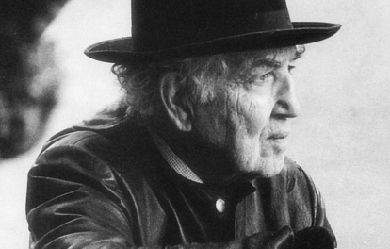
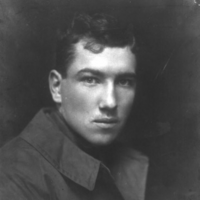
On July 24, 1895, Robert Graves was born in Wimbledon, near London. His father, Alfred Perceval Graves, was a Gaelic scholar and minor Irish poet. His mother, Amalie von Ranke Graves, was a relation of Leopold von Ranke, one of the founding fathers of modern historical studies. One of ten children, Robert was greatly influenced by his mother's puritanical beliefs and his father's love of Celtic poetry and myth. As a young man, he was more interested in boxing and mountain climbing than studying, although poetry later sustained him through a turbulent adolescence. In 1913 Graves won a scholarship to continue his studies at St. John's College, Oxford, but in August 1914 he enlisted as a junior officer in the Royal Welch Fusiliers. He fought in the Battle of Loos and was injured in the Somme offensive in 1916. While convalescing, he published his first collection of poetry, Over the Brazier. By 1917, though still an active serviceman, Graves had published three volumes. In 1918, he spent a year in the trenches, where he was again severely wounded. In January 1918, at the age of twenty-two, he married eighteen-year-old Nancy Nicholson, with whom he was to have four children. Traumatized by the war, he went to Oxford with his wife and took a position at St. John's College. Graves's early volumes of poetry, like those of his contemporaries, deal with natural beauty and bucolic pleasures, and with the consequences of the First World War. Over the Brazier and Fairies and Fusiliers earned for Graves the reputation as an accomplished war poet. After meeting the American poet and theorist Laura Riding in 1926, Graves's poetry underwent a significant transformation. Douglas Day has written that the "influence of Laura Riding is quite possibly the most important single element in [Graves's] poetic career: she persuaded him to curb his digressiveness and his rambling philosophizing and to concentrate instead on terse, ironic poems written on personal themes." In 1927, Graves and his first wife separated permanently, and in 1929 he published Goodbye to All That, an autobiography that announced his psychological accommodation with the residual horror of his war experiences. Shortly afterward, he departed to Majorca with Laura Riding. In addition to completing many books of verse while in Majorca, Graves also wrote several volumes of criticism, some in collaboration with Riding. The couple cofounded Seizin Press in 1928 and Epilogue, a semiannual magazine, in 1935. During that period, he evolved his theory of poetry as spiritually cathartic to both the poet and the reader. Although Graves claimed that he wrote novels only to earn money, it was through these that he attained status as a major writer in 1934, with the publication of the historical novel I, Claudius, and its sequel, Claudius the God and His Wife Messalina. (During the 1970's, the BBC adapted the novels into an internationally popular television series.) At the onset of the Spanish Civil War in 1936, Graves and Riding fled Majorca, eventually settling in America. In 1939, Laura Riding left Graves for the writer Schuyler Jackson; one year later Graves began a relationship with Beryl Hodge that was to last until his death. It was in the 1940s, after his break with Riding, that Graves formulated his personal mythology of the White Goddess. Inspired by late nineteenth-century studies of matriarchal societies and goddess cults, this mythology was to pervade all of his later work. After World War II, Graves returned to Majorca, where he lived with Hodge and continued to write. By the 1950s, Graves had won an enormous international reputation as a poet, novelist, literary scholar, and translator. In 1962, W. H. Auden went as far as to assert that Graves was England's "greatest living poet." In 1968, he received the Queen's Gold Medal for Poetry. During his lifetime he published more than 140 books, including fifty-five collections of poetry (he reworked his Collected Poems repeatedly during his career), fifteen novels, ten translations, and forty works of nonfiction, autobiography, and literary essays. From 1961 to 1966, Graves returned to England to serve as a professor of poetry at Oxford. In the 1970s his productivity fell off; and the last decade of his life was lost in silence and senility. Robert Graves died in Majorca in 1985, at the age of ninety. Poetry * Over the Brazier (1916) * Goliath and David (1917) * Fairies and Fusiliers (1918) * Treasure Box (1920) * Country Sentiment (1920) * The Pier-Glass (1921) * Whipperginny (1923) * To Whom Else? Deyá (1931) * The Poems of Robert Graves (1958) * Man Does, Woman Is (1964) * Love Respelt (1966) * Poems About Love (1969) * Love Respelt Again (1969) * Poems: Abridged for Dolls and Princes (1971) * Poems 1970-1972 (1973) * New Collected Poems (1977) * The Complete Poems, ed. Beryl Graves and Dunstan Ward (2000) References Poets.org - www.poets.org/poet.php/prmPID/193
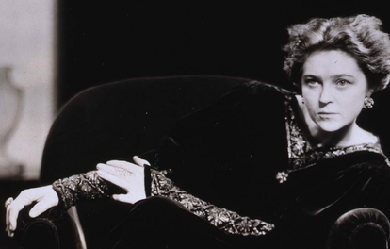
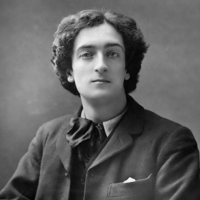
Richard Le Gallienne (20 January 1866– 15 September 1947) was an English author and poet. The American actress Eva Le Gallienne (1899–1991) was his daughter, by his second marriage. Life and career He was born in Liverpool. He started work in an accountant’s office, but abandoned this job to become a professional writer. The book My Ladies’ Sonnets appeared in 1887, and in 1889 he became, for a brief time, literary secretary to Wilson Barrett. He joined the staff of the newspaper The Star in 1891, and wrote for various papers by the name Logroller. He contributed to The Yellow Book, and associated with the Rhymers’ Club. His first wife, Mildred Lee, died in 1894. They had one daughter, Hesper. In 1897 he married the Danish journalist Julie Norregard, who left him in 1903 and took their daughter Eva to live in Paris. Le Gallienne subsequently became a resident of the United States. He has been credited with the 1906 translation from the Danish of Peter Nansen’s Love’s Trilogy; but most sources and the book itself attribute it to Julie. They were divorced in June 1911. On October 27, 1911, he married Mrs. Irma Perry, née Hinton, whose previous marriage to her first cousin, the painter and sculptor Roland Hinton Perry, had been dissolved in 1904. Le Gallienne and Irma had known each other for some time, and had jointly published an article as early as 1906. Irma’s daughter Gwendolyn Perry subsequently called herself “Gwen Le Gallienne”, but was almost certainly not his natural daughter, having been born in 1900. Le Gallienne and Irma lived in Paris from the late 1920s, where Gwen was by then an established figure in the expatriate bohéme (see, e.g.) and where he wrote a regular newspaper column. Le Gallienne lived in Menton on the French Riviera during the 1940s. During the Second World War Le Gallienne was prevented from returning to his Menton home and lived in Monaco for the rest of the war. Le Gallienne’s house in Menton was occupied by German troops and his library was nearly sent back to Germany as bounty. Le Gallienne appealed to a German officer in Monaco who allowed him to return to Menton to collect his books. During the war Le Gallienne refused to write propaganda for the local German and Italian authorities, and with no income, once collapsed in the street due to hunger. In later times he knew Llewelyn Powys and John Cowper Powys. Asked how to say his name, he told The Literary Digest the stress was “on the last syllable: le gal-i-enn’. As a rule I hear it pronounced as if it were spelled ‘gallion,’ which, of course, is wrong.” (Charles Earle Funk, What’s the Name, Please?, Funk & Wagnalls, 1936.) A number of his works are now available online. He also wrote the foreword to “The Days I Knew” by Lillie Langtry 1925, George H. Doran Company on Murray Hill New York. Works * My Ladies’ Sonnets and Other Vain and Amatorious Verses (1887) * Volumes in Folio (1889) poems * George Meredith: Some Characteristics (1890) * The Book-Bills of Narcissus (1891) * English Poems (1892) * The Religion of a Literary Man (1893) * Robert Louis Stevenson: An Elegy and Other Poems (1895) * Quest of the Golden Girl (1896) novel * Prose Fancies (1896) * Retrospective Reviews (1896) * Rubaiyat of Omar Khayyam (1897) * If I Were God (1897) * The Romance Of Zion Chapel (1898) * In Praise of Bishop Valentine (1898) * Young Lives (1899) * Sleeping Beauty and Other Prose Fancies (1900) * The Worshipper Of The Image (1900) * The Love Letters of the King, or The Life Romantic (1901) * An Old Country House (1902) * Odes from the Divan of Hafiz (1903) translation * Old Love Stories Retold (1904) * Painted Shadows (1904) * Romances of Old France (1905) * Little Dinners with the Sphinx and other Prose Fancies (1907) * Omar Repentant (1908) * Wagner’s Tristan and Isolde (1909) Translator * Attitudes and Avowals (1910) essays * October Vagabonds (1910) * New Poems (1910) * The Maker of Rainbows and Other Fairy-Tales and Fables (1912) * The Lonely Dancer and Other Poems (1913) * The Highway to Happiness (1913) * Vanishing Roads and Other Essays (1915) * The Silk-Hat Soldier and Other Poems in War Time (1915) * The Chain Invisible (1916) * Pieces of Eight (1918) * The Junk-Man and Other Poems (1920) * A Jongleur Strayed (1922) poems * Woodstock: An Essay (1923) * The Romantic '90s (1925) memoirs * The Romance of Perfume (1928) * There Was a Ship (1930) * From a Paris Garret (1936) memoirs * The Diary of Samuel Pepys (editor) References Wikipedia—https://en.wikipedia.org/wiki/Richard_Le_Gallienne
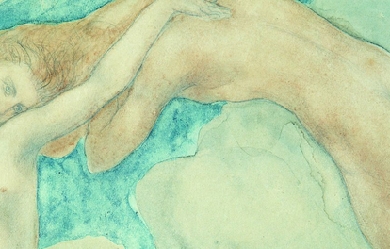
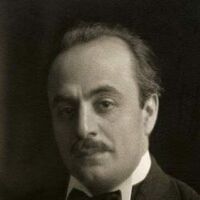
Khalil Gibran (Arabic pronunciation: [xaˈliːl ʒiˈbrɑːn]) (January 6, 1883 - April 10, 1931); born Gubran Khalil Gubran, was a Lebanese-American artist, poet, and writer. Born in the town of Bsharri in modern-day Lebanon (then part of the Ottoman Mount Lebanon mutasarrifate), as a young man he emigrated with his family to the United States where he studied art and began his literary career. In the Arab world, Gibran is regarded as a literary and political rebel. His Romantic style was at the heart of a renaissance in modern Arabic literature, especially prose poetry, breaking away from the classical school. In Lebanon, he is still celebrated as a literary hero. He is chiefly known in the English-speaking world for his 1923 book The Prophet, an early example of inspirational fiction including a series of philosophical essays written in poetic English prose. The book sold well despite a cool critical reception, gaining popularity in the 1930s and again especially in the 1960s counterculture. Gibran is the third best-selling poet of all time, behind Shakespeare and Lao-Tzu. In academic contexts his name is often spelled Jubrān Khalīl Jubrān,:217:255 Jibrān Khalīl Jibrān,:217:559 or Jibrān Xalīl Jibrān;:189 Arabic جبران خليل جبران , January 6, 1883 – April 10, 1931) also known as Kahlil Gibran, In Lebanon Gibran was born to a Maronite Catholic family from the historical town of Bsharri in northern Lebanon. His mother Kamila, daughter of a priest, was thirty when he was born; his father Khalil was her third husband. As a result of his family's poverty, Gibran received no formal schooling during his youth. However, priests visited him regularly and taught him about the Bible, as well as the Arabic and Syriac languages. Gibran's father initially worked in an apothecary but, with gambling debts he was unable to pay, he went to work for a local Ottoman-appointed administrator. Around 1891, extensive complaints by angry subjects led to the administrator being removed and his staff being investigated. Gibran's father was imprisoned for embezzlement, and his family's property was confiscated by the authorities. Kamila Gibran decided to follow her brother to the United States. Although Gibran's father was released in 1894, Kamila remained resolved and left for New York on June 25, 1895, taking Khalil, his younger sisters Mariana and Sultana, and his elder half-brother Peter (in Arabic, Butrus). In the United States The Gibrans settled in Boston's South End, at the time the second largest Syrian/Lebanese-American community in the United States. Due to a mistake at school, he was registered as Kahlil Gibran. His mother began working as a seamstress peddler, selling lace and linens that she carried from door to door. Gibran started school on September 30, 1895. School officials placed him in a special class for immigrants to learn English. Gibran also enrolled in an art school at a nearby settlement house. Through his teachers there, he was introduced to the avant-garde Boston artist, photographer, and publisher Fred Holland Day, who encouraged and supported Gibran in his creative endeavors. A publisher used some of Gibran's drawings for book covers in 1898. Gibran's mother, along with his elder brother Peter, wanted him to absorb more of his own heritage rather than just the Western aesthetic culture he was attracted to, so at the age of fifteen, Gibran returned to his homeland to study at a Maronite-run preparatory school and higher-education institute in Beirut, called Al-Hikma (The Wisdom). He started a student literary magazine with a classmate and was elected "college poet". He stayed there for several years before returning to Boston in 1902, coming through Ellis Island (a second time) on May 10. Two weeks before he got back, his sister Sultana died of tuberculosis at the age of 14. The next year, Peter died of the same disease and his mother died of cancer. His sister Marianna supported Gibran and herself by working at a dressmaker’s shop. Art and poetry Gibran held his first art exhibition of his drawings in 1904 in Boston, at Day's studio. During this exhibition, Gibran met Mary Elizabeth Haskell, a respected headmistress ten years his senior. The two formed an important friendship that lasted the rest of Gibran’s life. Though publicly discreet, their correspondence reveals that the two were lovers. In fact, Gibran twice proposed to her but marriage was not possible in the face of her family's conservatism. Haskell influenced not only Gibran’s personal life, but also his career. She became his editor, and introduced him to Charlotte Teller, a journalist,and Emilie Michel (Micheline), a French teacher, who accepted to pose for him as a model and became close friends. In 1908, Gibran went to study art in Paris for two years. While there he met his art study partner and lifelong friend Youssef Howayek. While most of Gibran's early writings were in Arabic, most of his work published after 1918 was in English. His first book for the publishing company Alfred A. Knopf, in 1918, was The Madman, a slim volume of aphorisms and parables written in biblical cadence somewhere between poetry and prose. Gibran also took part in the New York Pen League, also known as the "immigrant poets" (al-mahjar), alongside important Lebanese-American authors such as Ameen Rihani, Elia Abu Madi and Mikhail Naimy, a close friend and distinguished master of Arabic literature, whose descendants Gibran declared to be his own children, and whose nephew, Samir, is a godson of Gibran's. Much of Gibran's writings deal with Christianity, especially on the topic of spiritual love. But his mysticism is a convergence of several different influences : Christianity, Islam, Sufism, Hinduism and theosophy. He wrote : "You are my brother and I love you. I love you when you prostrate yourself in your mosque, and kneel in your church and pray in your synagogue. You and I are sons of one faith - the Spirit." Juliet Thompson, one of Gibran's acquaintances, reported several anecdotes relating to Gibran: She recalls Gibran met `Abdu'l-Bahá, the leader of the Bahá’í Faith at the time of his visit to the United States, circa 1911–1912. Barbara Young, in "This Man from Lebanon: A Study of Khalil Gibran", records Gibran was unable to sleep the night before meeting `Abdu'l-Bahá who sat for a pair of portraits. Thompson reports Gibran saying that all the way through writing of "Jesus, The Son of Man", he thought of `Abdu'l-Bahá. Years later, after the death of `Abdu'l-Bahá, there was a viewing of the movie recording of `Abdu'l-Bahá – Gibran rose to talk and in tears, proclaimed an exalted station of `Abdu'l-Bahá and left the event weeping. His poetry is notable for its use of formal language, as well as insights on topics of life using spiritual terms. Gibran's best-known work is The Prophet, a book composed of twenty-six poetic essays. Its popularity grew markedly during the 1960s with the American counterculture and then with the flowering of the New Age movements. It has remained popular with these and with the wider population to this day. Since it was first published in 1923, The Prophet has never been out of print. Having been translated into more than forty languages, it was one of the bestselling books of the twentieth century in the United States. One of his most notable lines of poetry is from "Sand and Foam" (1926), which reads: "Half of what I say is meaningless, but I say it so that the other half may reach you". This line was used by John Lennon and placed, though in a slightly altered form, into the song "Julia" from The Beatles' 1968 album The Beatles (a.k.a. "The White Album”). Drawing and painting Gibran was an accomplished artist, especially in drawing and watercolour, having attended art school in Paris from 1908 to 1910, pursuing a symbolist and romantic style over then up-and-coming realism. His more than 700 images include portraits of his friends WB Yeats, Carl Jung and August Rodin. A possible Gibran painting was the subject of a June 2012 episode of the PBS TV series History Detectives. Political thought Gibran was by no means a politician. He used to say : "I am not a politician, nor do I wish to become one" and "Spare me the political events and power struggles, as the whole earth is my homeland and all men are my fellow countrymen". Nevertheless, Gibran called for the adoption of Arabic as a national language of Syria, considered from a geographic point of view, not as a political entity. When Gibran met `Abdu'l-Bahá in 1911–12, who traveled to the United States partly to promote peace, Gibran admired the teachings on peace but argued that "young nations like his own" be freed from Ottoman control. Gibran also wrote the famous "Pity The Nation" poem during these years, posthumously published in The Garden of the Prophet. When the Ottomans were finally driven out of Syria during World War I, Gibran's exhilaration was manifested in a sketch called "Free Syria" which appeared on the front page of al-Sa'ih's special "victory" edition. Moreover, in a draft of a play, still kept among his papers, Gibran expressed great hope for national independence and progress. This play, according to Khalil Hawi, "defines Gibran's belief in Syrian nationalism with great clarity, distinguishing it from both Lebanese and Arab nationalism, and showing us that nationalism lived in his mind, even at this late stage, side by side with internationalism.” Death and legacy Gibran died in New York City on April 10, 1931: the cause was determined to be cirrhosis of the liver and tuberculosis. Before his death, Gibran expressed the wish that he be buried in Lebanon. This wish was fulfilled in 1932, when Mary Haskell and his sister Mariana purchased the Mar Sarkis Monastery in Lebanon, which has since become the Gibran Museum. The words written next to Gibran's grave are "a word I want to see written on my grave: I am alive like you, and I am standing beside you. Close your eyes and look around, you will see me in front of you ...." Gibran willed the contents of his studio to Mary Haskell. There she discovered her letters to him spanning twenty-three years. She initially agreed to burn them because of their intimacy, but recognizing their historical value she saved them. She gave them, along with his letters to her which she had also saved, to the University of North Carolina at Chapel Hill Library before she died in 1964. Excerpts of the over six hundred letters were published in "Beloved Prophet" in 1972. Mary Haskell Minis (she wed Jacob Florance Minis in 1923) donated her personal collection of nearly one hundred original works of art by Gibran to the Telfair Museum of Art in Savannah, Georgia in 1950. Haskell had been thinking of placing her collection at the Telfair as early as 1914. In a letter to Gibran, she wrote "I am thinking of other museums ... the unique little Telfair Gallery in Savannah, Ga., that Gari Melchers chooses pictures for. There when I was a visiting child, form burst upon my astonished little soul." Haskell's gift to the Telfair is the largest public collection of Gibran’s visual art in the country, consisting of five oils and numerous works on paper rendered in the artist’s lyrical style, which reflects the influence of symbolism. The future American royalties to his books were willed to his hometown of Bsharri, to be "used for good causes”. Works In Arabic: * Nubthah fi Fan Al-Musiqa (Music, 1905) * Ara'is al-Muruj (Nymphs of the Valley, also translated as Spirit Brides and Brides of the Prairie, 1906) * al-Arwah al-Mutamarrida (Rebellious Spirits, 1908) * al-Ajniha al-Mutakassira (Broken Wings, 1912) * Dam'a wa Ibtisama (A Tear and A Smile, 1914) * al-Mawakib (The Processions, 1919) * al-‘Awāsif (The Tempests, 1920) * al-Bada'i' waal-Tara'if (The New and the Marvellous, 1923) In English, prior to his death: * The Madman (1918) (downloadable free version) * Twenty Drawings (1919) * The Forerunner (1920) * The Prophet, (1923) * Sand and Foam (1926) * Kingdom of the Imagination (1927) * Jesus, The Son of Man (1928) * The Earth Gods (1931) Posthumous, in English: * The Wanderer (1932) * The Garden of the Prophet (1933, Completed by Barbara Young) * Lazarus and his Beloved (Play, 1933) Collections: * Prose Poems (1934) * Secrets of the Heart (1947) * A Treasury of Kahlil Gibran (1951) * A Self-Portrait (1959) * Thoughts and Meditations (1960) * A Second Treasury of Kahlil Gibran (1962) * Spiritual Sayings (1962) * Voice of the Master (1963) * Mirrors of the Soul (1965) * Between Night & Morn (1972) * A Third Treasury of Kahlil Gibran (1975) * The Storm (1994) * The Beloved (1994) * The Vision (1994) * Eye of the Prophet (1995) * The Treasured Writings of Kahlil Gibran (1995) Other: * Beloved Prophet, The love letters of Khalil Gibran and Mary Haskell, and her private journal (1972, edited by Virginia Hilu) Memorials and honors * Lebanese Ministry of Post and Telecommunications published a stamp in his honor in 1971. * Gibran Museum in Bsharri, Lebanon * Gibran Khalil Gibran Garden, Beirut, Lebanon * Gibran Khalil Gibran collectin, Soumaya Museum, Mexico. * Kahlil Gibran Street, Ville Saint-Laurent, Quebec, Canada inaugurated on 27 Sept. 2008 on occasion of the 125th anniversary of his birth. * Gibran Kahlil Gibran Skiing Piste, The Cedars Ski Resort, Lebanon * Kahlil Gibran Memorial Garden in Washington, D.C., dedicated in 1990 * The Kahlil Gibran Chair for Values and Peace, University of Maryland, currently held by Suheil Bushrui * Pavilion K. Gibran at École Pasteur in Montréal, Quebec, Canada * Gibran Memorial Plaque in Copley Square, Boston, Massachusetts see Kahlil Gibran (sculptor). * Khalil Gibran International Academy, a public high school in Brooklyn, NY, opened in September 2007 * Khalil Gibran Park (Parcul Khalil Gibran) in Bucharest, Romania * Gibran Kalil Gibran sculpture on a marble pedestal indoors at Arab Memorial building at Curitiba, Paraná, Brazil * Gibran Khalil Gibran Memorial, in front of Plaza de las Naciones. Buenos Aires. References Wikipedia - http://en.wikipedia.org/wiki/Khalil_Gibran
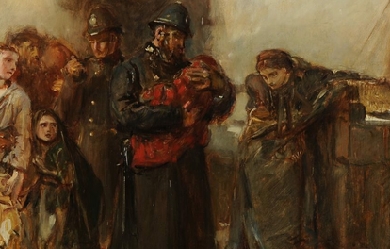
.jpg)
Sir William Schwenck Gilbert (18 November 1836– 29 May 1911) was an English dramatist, librettist, poet and illustrator best known for the fourteen comic operas (known as the Savoy operas) produced in collaboration with the composer Sir Arthur Sullivan. The most famous of these include H.M.S. Pinafore, The Pirates of Penzance and one of the most frequently performed works in the history of musical theatre, The Mikado. These, as well as several of the other Savoy operas, continue to be frequently performed in the English-speaking world and beyond by opera companies, repertory companies, schools and community theatre groups. Lines from these works have become part of the English language, such as “short, sharp shock”, “What, never? Well, hardly ever!”, and “Let the punishment fit the crime”. Gilbert also wrote the Bab Ballads, an extensive collection of light verse accompanied by his own comical drawings. His creative output included over 75 plays and libretti, numerous stories, poems, lyrics and various other comic and serious pieces. His plays and realistic style of stage direction inspired other dramatists, including Oscar Wilde and George Bernard Shaw. According to The Cambridge History of English and American Literature, Gilbert’s “lyrical facility and his mastery of metre raised the poetical quality of comic opera to a position that it had never reached before and has not reached since”. Early life and career Beginnings Gilbert was born at 17 Southampton Street, Strand, London. His father, also named William, was briefly a naval surgeon, who later became a writer of novels and short stories, some of which were illustrated by his son. Gilbert’s mother was the former Anne Mary Bye Morris (1812–1888), the daughter of Thomas Morris, an apothecary. Gilbert’s parents were distant and stern, and he did not have a particularly close relationship with either of them. They quarrelled increasingly, and following the break-up of their marriage in 1876, his relationships with them, especially his mother, became even more strained. Gilbert had three younger sisters, two of whom were born outside England because of the family’s travels during these years: Jane Morris (b. 1838 in Milan, Italy– 1906), who married Alfred Weigall, a miniatures painter; Anne Maude (1845–1932) and Mary Florence (b. 1843 in Boulogne, France– 1911), neither of whom married. Gilbert was nicknamed “Bab” as a baby, and then “Schwenck”, after his father’s godparents. As a child, Gilbert travelled to Italy in 1838 and then France for two years with his parents, who finally returned to settle in London in 1847. He was educated at Boulogne, France from the age of seven (he later kept his diary in French so that the servants could not read it), then at Western Grammar School, Brompton, London, and then at the Great Ealing School, where he became head boy and wrote plays for school performances and painted scenery. He then attended King’s College London, graduating in 1856. He intended to take the examinations for a commission in the Royal Artillery, but with the end of the Crimean War, fewer recruits were needed, and the only commission available to Gilbert would have been in a line regiment. Instead he joined the Civil Service: he was an assistant clerk in the Privy Council Office for four years and hated it. In 1859 he joined the Militia, a part-time volunteer force formed for the defence of Britain, with which he served until 1878 (in between writing and other work), reaching the rank of Captain. In 1863 he received a bequest of £300 that he used to leave the civil service and take up a brief career as a barrister (he had already entered the Inner Temple as a student), but his legal practice was not successful, averaging just five clients a year. To supplement his income from 1861 on, Gilbert wrote a variety of stories, comic rants, grotesque illustrations, theatre reviews (many in the form of a parody of the play being reviewed), and, under the pseudonym “Bab” (his childhood nickname), illustrated poems for several comic magazines, primarily Fun, started in 1861 by H. J. Byron. He published stories, articles, and reviews in papers such as the Cornhill Magazine, London Society, Tinsley’s Magazine and Temple Bar. In addition, Gilbert was the London correspondent for L’Invalide Russe and a drama critic for the Illustrated London Times. In the 1860s he also contributed to Tom Hood’s Christmas annuals, to Saturday Night, the Comic News and the Savage Club Papers. The Observer newspaper in 1870 sent him to France as a war correspondent reporting on the Franco-Prussian War. The poems, illustrated humorously by Gilbert, proved immensely popular and were reprinted in book form as the Bab Ballads. He would later return to many of these as source material for his plays and comic operas. Gilbert and his colleagues from Fun, including Tom Robertson, Tom Hood, Clement Scott and F. C. Burnand (who defected to Punch in 1862) frequented the Arundel Club, the Savage Club, and especially Evans’s café, where they had a table in competition with the Punch 'Round table’. After a relationship in the mid-1860s with novelist Annie Thomas, Gilbert married Lucy Agnes Turner, whom he called “Kitty”, in 1867; she was 11 years his junior. He wrote many affectionate letters to her over the years. Gilbert and Lucy were socially active both in London and later at Grim’s Dyke, often holding dinner parties and being invited to others’ homes for dinner, in contrast to the picture painted by fictionalisations such as the film Topsy-Turvy. The Gilberts had no children, but they had many pets, including some exotic ones. First plays Gilbert wrote and directed a number of plays at school, but his first professionally produced play was Uncle Baby, which ran for seven weeks in the autumn of 1863. In 1865–66, Gilbert collaborated with Charles Millward on several pantomimes, including one called Hush-a-Bye, Baby, On the Tree Top, or, Harlequin Fortunia, King Frog of Frog Island, and the Magic Toys of Lowther Arcade (1866). Gilbert’s first solo success, however, came a few days after Hush-a-Bye Baby premiered. His friend and mentor, Tom Robertson, was asked to write a pantomime but did not think he could do it in the two weeks available, and so he recommended Gilbert instead. Written and rushed to the stage in 10 days, Dulcamara, or the Little Duck and the Great Quack, a burlesque of Gaetano Donizetti’s L’elisir d’amore, proved extremely popular. This led to a long series of further Gilbert opera burlesques, pantomimes and farces, full of awful puns (traditional in burlesques of the period), though showing, at times, signs of the satire that would later be a defining part of Gilbert’s work. For instance: This was followed by Gilbert’s penultimate operatic parody, Robert the Devil, a burlesque of Giacomo Meyerbeer’s opera, Robert le diable, which was part of a triple bill that opened the Gaiety Theatre, London in 1868. The piece was Gilbert’s biggest success to date, running for over 100 nights and being frequently revived and played continuously in the provinces for three years thereafter. In Victorian theatre, "[to degrade] high and beautiful themes... had been the regular proceeding in burlesque, and the age almost expected it" However, Gilbert’s burlesques were considered unusually tasteful compared to the others on the London stage. Isaac Goldberg wrote that these pieces “reveal how a playwright may begin by making burlesque of opera and end by making opera of burlesque.” Gilbert would depart even further from the burlesque style from about 1869 with plays containing original plots and fewer puns. His first full-length prose comedy was An Old Score (1869). German Reed entertainments and other plays of the early 1870s Theatre, at the time Gilbert began writing, had fallen into disrepute. Badly translated and adapted French operettas and poorly written, prurient Victorian burlesques dominated the London stage. As Jessie Bond vividly described it, “stilted tragedy and vulgar farce were all the would-be playgoer had to choose from, and the theatre had become a place of evil repute to the righteous British householder.” From 1869 to 1875, Gilbert joined with one of the leading figures in theatrical reform, Thomas German Reed (and his wife Priscilla), whose Gallery of Illustration sought to regain some of theatre’s lost respectability by offering family entertainments in London. So successful were they that by 1885 Gilbert stated that original British plays were appropriate for an innocent 15-year-old girl in the audience. Three months before the opening of Gilbert’s last burlesque (The Pretty Druidess), the first of his pieces for the Gallery of Illustration, No Cards, was produced. Gilbert created six musical entertainments for the German Reeds, some with music composed by Thomas German Reed himself. The environment of the German Reeds’ intimate theatre allowed Gilbert quickly to develop a personal style and freedom to control all aspects of production, including set, costumes, direction and stage management. These works were a success, with Gilbert’s first big hit at the Gallery of Illustration, Ages Ago, opening in 1869. Ages Ago was also the beginning of a collaboration with the composer Frederic Clay that would last seven years and produce four works. It was at a rehearsal for Ages Ago that Clay formally introduced Gilbert to his friend, Arthur Sullivan. The Bab Ballads and Gilbert’s many early musical works gave him much practice as a lyricist even before his collaboration with Sullivan. Many of the plot elements of the German Reed Entertainments (as well as some from his earlier plays and Bab Ballads) would be reused by Gilbert later in the Gilbert and Sullivan operas. These elements include paintings coming to life (Ages Ago, used again in Ruddigore), a deaf nursemaid binding a respectable man’s son to a “pirate” instead of to a “pilot” by mistake (Our Island Home, 1870, reused in The Pirates of Penzance), and the forceful mature lady who is “an acquired taste” (Eyes and No Eyes, 1875, reused in The Mikado). During this time, Gilbert perfected the 'topsy-turvy’ style that he had been developing in his Bab Ballads, where the humour was derived by setting up a ridiculous premise and working out its logical consequences, however absurd. Mike Leigh describes the “Gilbertian” style as follows: "With great fluidity and freedom, [Gilbert] continually challenges our natural expectations. First, within the framework of the story, he makes bizarre things happen, and turns the world on its head. Thus the Learned Judge marries the Plaintiff, the soldiers metamorphose into aesthetes, and so on, and nearly every opera is resolved by a deft moving of the goalposts... His genius is to fuse opposites with an imperceptible sleight of hand, to blend the surreal with the real, and the caricature with the natural. In other words, to tell a perfectly outrageous story in a completely deadpan way.” At the same time, Gilbert created several 'fairy comedies’ at the Haymarket Theatre. This series of plays was founded upon the idea of self-revelation by characters under the influence of some magic or some supernatural interference. The first was The Palace of Truth (1870), based partly on a story by Madame de Genlis. In 1871, with Pygmalion and Galatea, one of seven plays that he produced that year, Gilbert scored his greatest hit to date. Together, these plays and their successors such as The Wicked World (1873), Sweethearts (1874), and Broken Hearts (1875), did for Gilbert on the dramatic stage what the German Reed entertainments had done for him on the musical stage: they established that his capabilities extended far beyond burlesque, won him artistic credentials, and demonstrated that he was a writer of wide range, as comfortable with human drama as with farcical humour. The success of these plays, especially Pygmalion and Galatea, gave Gilbert a prestige that would be crucial to his later collaboration with as respected a musician as Sullivan. Though dated, these works demonstrate Gilbert’s desire to give respectable and well-educated theatre audiences comedies that were more refined and tasteful than the usual farces and burlesques playing in London. On the other hand, during the same period, Gilbert pushed the boundaries of how far satire could go in the theatre. He collaborated with Gilbert Arthur à Beckett on The Happy Land (1873), a political satire (in part, a parody of his own The Wicked World), which was briefly banned because of its unflattering caricatures of Gladstone and his ministers. Similarly, The Realm of Joy (1873) was set in the lobby of a theatre performing a scandalous play (implied to be the Happy Land), with many jokes at the expense of the Lord Chamberlain (the “Lord High Disinfectant”, as he’s referred to in the play). In Charity (1874), however, Gilbert uses the freedom of the stage in a different way: to provide a tightly-written critique of the contrasting ways in which Victorian society treated men and women who had sex outside of marriage, which anticipated the 'problem plays’ of Shaw and Ibsen. As a director Once he became established, Gilbert was the stage director for his plays and operas and had strong opinions on how they should best be performed. He was strongly influenced by the innovations in 'stagecraft’, now called stage direction, by the playwrights James Planché and especially Tom Robertson. Gilbert attended rehearsals directed by Robertson to learn this art firsthand from the older director, and he began to apply it in some of his earliest plays. He sought realism in acting, settings, costumes and movement, if not in content of his plays (although he did write a romantic comedy in the “naturalist” style, as a tribute to Robertson, Sweethearts), shunned self-conscious interaction with the audience, and insisted on a style of portrayal in which the characters were never aware of their own absurdity, but were coherent internal wholes. In Gilbert’s 1874 burlesque, Rosencrantz and Guildenstern, the character Hamlet, in his speech to the players, sums up Gilbert’s theory of comic acting: “I hold that there is no such antick fellow as your bombastical hero who doth so earnestly spout forth his folly as to make his hearers believe that he is unconscious of all incongruity”. With his work along these lines, Gilbert set the ground for later playwrights such as George Bernard Shaw and Oscar Wilde to be able to flourish on the English stage. Robertson "introduced Gilbert both to the revolutionary notion of disciplined rehearsals and to mise-en-scène or unity of style in the whole presentation– direction, design, music, acting." Like Robertson, Gilbert demanded discipline in his actors. He required that his actors know their words perfectly, enunciate them clearly and obey his stage directions, which was something quite new to many actors of the day. A major innovation was the replacement of the star actor with the disciplined ensemble, “raising the director to a new position of dominance” in the theatre. “That Gilbert was a good director is not in doubt. He was able to extract from his actors natural, clear performances, which served the Gilbertian requirements of outrageousness delivered straight.” Gilbert prepared meticulously for each new work, making models of the stage, actors and set pieces, and designing every action and bit of business in advance. Gilbert would not work with actors who challenged his authority. Even during long runs and revivals, Gilbert closely supervised the performances of his plays, making sure that the actors did not make unauthorised additions, deletions or paraphrases. Gilbert was famous for demonstrating the action himself, even as he grew older. Gilbert himself went on stage in a number of productions throughout his lifetime, including several performances as the Associate in Trial by Jury, as substitute for an ailing actor in his play Broken Hearts, and in charity matinees of his one-act plays, such as King Claudius in Rosencrantz and Guildenstern. Collaboration with Sullivan First collaborations amidst other works In 1871, John Hollingshead commissioned Gilbert to work with Sullivan on a holiday piece for Christmas, Thespis, or The Gods Grown Old, at the Gaiety Theatre. Thespis outran five of its nine competitors for the 1871 holiday season, and its run was extended beyond the length of a normal run at the Gaiety, However, nothing more came of it at that point, and Gilbert and Sullivan went their separate ways. Gilbert worked again with Clay on Happy Arcadia (1872), and with Alfred Cellier on Topsyturveydom (1874), as well as writing several farces, operetta libretti, extravaganzas, fairy comedies, adaptations from novels, translations from the French, and the dramas described above. Also in 1874, he published his last contribution for Fun magazine ("Rosencrantz and Guildenstern"), after a gap of three years, then resigned due to disapproval of the new owner’s other publishing interests. It would be nearly four years after Thespis was produced before the two men worked together again. In 1868, Gilbert had published a short comedic sketch libretto in Fun magazine entitled “Trial by Jury: An Operetta”. In 1873, Gilbert arranged with the theatrical manager and composer, Carl Rosa, to expand the piece into a one-act libretto. Rosa’s wife was to sing the role of the plaintiff. However, Rosa’s wife died in childbirth in 1874. Later in 1874 Gilbert offered the libretto to Richard D’Oyly Carte, but Carte could not use the piece at that time. By early 1875, Carte was managing the Royalty Theatre, and he needed a short opera to be played as an afterpiece to Offenbach’s La Périchole. He contacted Gilbert, asked about the piece, and suggested Sullivan to set the work. Sullivan was enthusiastic, and Trial by Jury was composed in a matter of weeks. The little piece was a runaway hit, outlasting the run of La Périchole and being revived at another theatre. Gilbert continued his quest to gain respect in and respectability for his profession. One thing that may have been holding dramatists back from respectability was that plays were not published in a form suitable for a “gentleman’s library”, as, at the time, they were generally cheaply and unattractively published for the use of actors rather than the home reader. To help rectify this, at least for himself, Gilbert arranged in late 1875 for publishers Chatto and Windus to print a volume of his plays in a format designed to appeal to the general reader, with an attractive binding and clear type, containing Gilbert’s most respectable plays, including his most serious works, but mischievously capped off with Trial by Jury. After the success of Trial by Jury, there were discussions towards reviving Thespis, but Gilbert and Sullivan were not able to agree on terms with Carte and his backers. The score to Thespis was never published, and most of the music is now lost. It took some time for Carte to gather funds for another Gilbert and Sullivan opera, and in this gap Gilbert produced several works including Tom Cobb (1875), Eyes and No Eyes (1875, his last German Reed Entertainment), and Princess Toto (1876), his last and most ambitious work with Clay, a three-act comic opera with full orchestra, as opposed to the shorter works for much reduced accompaniment that came before. Gilbert also wrote two serious works during this time, Broken Hearts (1875) and Dan’l Druce, Blacksmith (1876). Also during this period, Gilbert wrote his most successful comic play, Engaged (1877), which inspired Oscar Wilde’s The Importance of Being Earnest. Engaged is a parody of romantic drama written in the “topsy-turvy” satiric style of many of Gilbert’s Bab Ballads and the Savoy Operas, with one character pledging his love, in the most poetic and romantic language possible, to every single woman in the play; the “innocent” Scottish rustics being revealed to be making a living through throwing trains off the lines and then charging the passengers for services, and, in general, romance being gladly thrown over in favour of monetary gain. Engaged continues to be performed today by both professional and amateur companies. Peak collaborative years Carte finally assembled a syndicate in 1877 and formed the Comedy Opera Company to launch a series of original English comic operas, beginning with a third collaboration between Gilbert and Sullivan, The Sorcerer, in November 1877. This work was a modest success, and H.M.S. Pinafore followed in May 1878. Despite a slow start, mainly due to a scorching summer, Pinafore became a red-hot favourite by autumn. After a dispute with Carte over the division of profits, the other Comedy Opera Company partners hired thugs to storm the theatre one night to steal the sets and costumes, intending to mount a rival production. The attempt was repelled by stagehands and others at the theatre loyal to Carte, and Carte continued as sole impresario of the newly renamed D’Oyly Carte Opera Company. Indeed, Pinafore was so successful that over a hundred unauthorised productions sprang up in America alone. Gilbert, Sullivan and Carte tried for many years to control the American performance copyrights over their operas, without success. For the next decade, the Savoy Operas (as the series came to be known, after the theatre Carte later built to house them) were Gilbert’s principal activity. The successful comic operas with Sullivan continued to appear every year or two, several of them being among the longest-running productions up to that point in the history of the musical stage. After Pinafore came The Pirates of Penzance (1879), Patience (1881), Iolanthe (1882), Princess Ida (1884, based on Gilbert’s earlier farce, The Princess), The Mikado (1885), Ruddigore (1887), The Yeomen of the Guard (1888), and The Gondoliers (1889). Gilbert not only directed and oversaw all aspects of production for these works, but he actually designed the costumes himself for Patience, Iolanthe, Princess Ida, and Ruddigore. He insisted on precise and authentic sets and costumes, which provided a foundation to ground and focus his absurd characters and situations. During this time, Gilbert and Sullivan also collaborated on one other major work, the oratorio The Martyr of Antioch, premiered at the Leeds music festival in October 1880. Gilbert arranged the original epic poem by Henry Hart Milman into a libretto suitable for the music, and it contains some original work. During this period, also, Gilbert occasionally wrote plays to be performed elsewhere–both serious dramas (for example The Ne’er-Do-Weel, 1878; and Gretchen, 1879) and humorous works (for example Foggerty’s Fairy, 1881). However, he no longer needed to turn out multiple plays each year, as he had done before. Indeed, during the more than nine years that separated The Pirates of Penzance and The Gondoliers, he wrote just three plays outside of the partnership with Sullivan. Only one of these works, Comedy and Tragedy, proved successful. In 1878, Gilbert realised a lifelong dream to play Harlequin, which he did at the Gaiety Theatre as part of an amateur charity production of The Forty Thieves, partly written by himself. Gilbert trained for Harlequin’s stylised dancing with his friend John D’Auban, who had arranged the dances for some of his plays and would choreograph most of the Gilbert and Sullivan operas. Producer John Hollingshead later remembered, “the gem of the performance was the grimly earnest and determined Harlequin of W. S. Gilbert. It gave me an idea of what Oliver Cromwell would have made of the character.” Another member of the cast recalled that Gilbert was tirelessly enthusiastic about the piece and often invited the cast to his home for dinner extra rehearsals. “A pleasanter, more genial, or agreeable companion than he was it would have been difficult, if not impossible, to find.” In 1882, Gilbert had a telephone installed in his home and at the prompt desk at the Savoy Theatre, so that he could monitor performances and rehearsals from his home study. Gilbert had referred to the new technology in Pinafore in 1878, only two years after the device was invented and before London even had telephone service. Carpet quarrel and end of the collaboration Gilbert sometimes had a strained working relationship with Sullivan, partly because each man saw himself allowing his work to be subjugated to the other’s, and partly due to their opposing personalities. Gilbert was often confrontational and notoriously thin-skinned, though prone to acts of extraordinary kindness, while Sullivan eschewed conflict. In addition, Gilbert imbued his libretti with “topsy-turvy” situations in which the social order was turned upside down. After a time, these subjects were often at odds with Sullivan’s desire for realism and emotional content. In addition, Gilbert’s political satire often poked fun at those in the circles of privilege, while Sullivan was eager to socialise among the wealthy and titled people who would become his friends and patrons. Throughout their collaboration, Gilbert and Sullivan disagreed several times over the choice of a subject. After both Princess Ida and Ruddigore, which were less successful than the seven other operas from H.M.S. Pinafore to The Gondoliers, Sullivan asked to leave the partnership, saying that he found Gilbert’s plots repetitive and that the operas were not artistically satisfying to him. While the two artists worked out their differences, Carte kept the Savoy open with revivals of their earlier works. On each occasion, after a few months’ pause, Gilbert responded with a libretto that met Sullivan’s objections, and the partnership continued successfully. In April 1890, during the run of The Gondoliers, however, Gilbert challenged Carte over the expenses of the production. Among other items to which Gilbert objected, Carte had charged the cost of a new carpet for the Savoy Theatre lobby to the partnership. Gilbert believed that this was a maintenance expense that should be charged to Carte alone. Gilbert confronted Carte, who refused to reconsider the accounts. Gilbert stormed out and wrote to Sullivan that “I left him with the remark that it was a mistake to kick down the ladder by which he had risen”. Helen Carte wrote that Gilbert had addressed Carte “in a way that I should not have thought you would have used to an offending menial.” As scholar Andrew Crowther has explained: After all, the carpet was only one of a number of disputed items, and the real issue lay not in the mere money value of these things, but in whether Carte could be trusted with the financial affairs of Gilbert and Sullivan. Gilbert contended that Carte had at best made a series of serious blunders in the accounts, and at worst deliberately attempted to swindle the others. It is not easy to settle the rights and wrongs of the issue at this distance, but it does seem fairly clear that there was something very wrong with the accounts at this time. Gilbert wrote to Sullivan on 28 May 1891, a year after the end of the “Quarrel”, that Carte had admitted "an unintentional overcharge of nearly £1,000 in the electric lighting accounts alone.” Gilbert brought suit, and after The Gondoliers closed in 1891, he withdrew the performance rights to his libretti, vowing to write no more operas for the Savoy. Gilbert next wrote The Mountebanks with Alfred Cellier and the flop Haste to the Wedding with George Grossmith, and Sullivan wrote Haddon Hall with Sydney Grundy. Gilbert eventually won the lawsuit and felt vindicated, but his actions and statements had been hurtful to his partners. Nevertheless, the partnership had been so profitable that, after the financial failure of the Royal English Opera House, Carte and his wife sought to reunite the author and composer. In 1891, after many failed attempts at reconciliation by the pair, Tom Chappell, the music publisher responsible for printing the Gilbert and Sullivan operas, stepped in to mediate between two of his most profitable artists, and within two weeks had succeeded. Two more operas resulted: Utopia, Limited (1893) and The Grand Duke (1896). Gilbert also offered a third libretto to Sullivan (His Excellency, 1894), but Gilbert’s insistence on casting Nancy McIntosh, his protegée from Utopia, led to Sullivan’s refusal. Utopia, concerning an attempt to “anglicise” a south Pacific island kingdom, was only a modest success, and The Grand Duke, in which a theatrical troupe, by means of a “statutory duel” and a conspiracy, takes political control of a grand duchy, was an outright failure. After that, the partnership ended for good. Sullivan continued to compose comic opera with other librettists but died four years later. In 1904, Gilbert would write, “... Savoy opera was snuffed out by the deplorable death of my distinguished collaborator, Sir Arthur Sullivan. When that event occurred, I saw no one with whom I felt that I could work with satisfaction and success, and so I discontinued to write libretti.” Later years Gilbert built the Garrick Theatre in 1889. The Gilberts moved to Grim’s Dyke in Harrow in 1890, which he purchased from Robert Heriot, to whom the artist Frederick Goodall had sold the property in 1880. In 1891, Gilbert was appointed Justice of the Peace for Middlesex. After casting Nancy McIntosh in Utopia, Limited, he and Lady Gilbert developed an affection for her, and she eventually gained the status of an unofficially adopted daughter, moving to Grim’s Dyke to live with them. She continued living there, even after Gilbert’s death, until Lady Gilbert’s death in 1936. A statue of Charles II, carved by Danish sculptor Caius Gabriel Cibber in 1681, was moved in 1875 from Soho Square to an island in the lake at Grim’s Dyke, where it remained when Gilbert purchased the property. On Lady Gilbert’s direction, it was restored to Soho Square in 1938. Although Gilbert announced a retirement from the theatre after the poor initial run of his last work with Sullivan, The Grand Duke (1896) and the poor reception of his 1897 play The Fortune Hunter, he produced at least three more plays over the last dozen years of his life, including an unsuccessful opera, Fallen Fairies (1909), with Edward German. Gilbert also continued to supervise the various revivals of his works by the D’Oyly Carte Opera Company, including its London Repertory seasons in 1906–09. His last play, The Hooligan, produced just four months before his death, is a study of a young condemned thug in a prison cell. Gilbert shows sympathy for his protagonist, the son of a thief who, brought up among thieves, kills his girlfriend. As in some earlier work, the playwright displays “his conviction that nurture rather than nature often accounted for criminal behaviour”. The grim and powerful piece became one of Gilbert’s most successful serious dramas, and experts conclude that, in those last months of Gilbert’s life, he was developing a new style, a “mixture of irony, of social theme, and of grubby realism,” to replace the old “Gilbertianism” of which he had grown weary. In these last years, Gilbert also wrote children’s book versions of H.M.S. Pinafore and The Mikado giving, in some cases, backstory that is not found in the librettos. Gilbert was knighted on 15 July 1907 in recognition of his contributions to drama. Sullivan had been knighted for his contributions to music almost a quarter of a century earlier, in 1883. Gilbert was, however, the first British writer ever to receive a knighthood for his plays alone—earlier dramatist knights, such as Sir William Davenant and Sir John Vanbrugh, were knighted for political and other services. On 29 May 1911, Gilbert was about to give a swimming lesson to two young women, Winifred Isabel Emery (1890–1972), and 17-year-old Ruby Preece in the lake of his home, Grim’s Dyke, when Preece lost her footing and called for help. Gilbert dived in to save her but suffered a heart attack in the middle of the lake and died. He was cremated at Golders Green and his ashes buried at the Church of St. John the Evangelist, Stanmore. The inscription on Gilbert’s memorial on the south wall of the Thames Embankment in London reads: “His Foe was Folly, and his Weapon Wit”. There is also a memorial plaque at All Saints’ Church, Harrow Weald. Personality Gilbert was known for being prickly. Aware of this general impression, he claimed that “If you give me your attention”, the misanthrope’s song from Princess Ida, was a satiric self-reference, saying: “I thought it my duty to live up to my reputation.” However, many people have defended him, often citing his generosity. Actress May Fortescue recalled, “His kindness was extraordinary. On wet nights and when rehearsals were late and the last buses were gone, he would pay the cab-fares of the girls whether they were pretty or not, instead of letting them trudge home on foot... He was just as large-hearted when he was poor as when he was rich and successful. For money as money he cared less than nothing. Gilbert was no plaster saint, but he was an ideal friend.” Journalist Frank M. Boyd wrote: I fancy that seldom was a man more generally given credit for a personality quite other than his own, than was the case with Sir W. S. Gilbert... Till one actually came to know the man, one shared the opinion held by so many, that he was a gruff, disagreeable person; but nothing could be less true of the really great humorist. He had rather a severe appearance... and like many other clever people, he had precious little use for fools of either sex, but he was at heart as kindly and lovable a man as you could wish to meet. Jessie Bond wrote that Gilbert “was quick-tempered, often unreasonable, and he could not bear to be thwarted, but how anyone could call him unamiable I cannot understand.” George Grossmith wrote to The Daily Telegraph that, although Gilbert had been described as an autocrat at rehearsals, “That was really only his manner when he was playing the part of stage director at rehearsals. As a matter of fact, he was a generous, kind true gentleman, and I use the word in the purest and original sense.” Aside from his occasional creative disagreements with, and eventual rift from, Sullivan, Gilbert’s temper led to the loss of friendships with a number of people. For instance, he quarrelled with his old associate C. H. Workman, over the firing of Nancy McIntosh from the production of Fallen Fairies, and with actress Henrietta Hodson. He also saw his friendship with theatre critic Clement Scott turn bitter. However, Gilbert could be extraordinarily kind. During Scott’s final illness in 1904, for instance, Gilbert donated to a fund for him, visited nearly every day, and assisted Scott’s wife, despite having not been on friendly terms with him for the previous sixteen years. Similarly, Gilbert had written several plays at the behest of comic actor Ned Sothern. However, Sothern died before he could perform the last of these, Foggerty’s Fairy. Gilbert purchased the play back from his grateful widow. According to one London society lady: [Gilbert]'s wit was innate, and his rapier-like retorts slipped out with instantaneous ease. His mind was naturally fastidious and clean; he never asserted himself, never tried to make an effect. He was great-hearted and most understanding, with an underlying poetry of fancy that made him the most delicious companion. They spoke of his quick temper, but that was entirely free from malice or guile. He was soft-hearted as a babe, but there was nothing of the hypocrite about him. What he thought he said on the instant, and though by people of sensitive vanity this might on occasion be resented, to a sensitiveness of a finer kind it was an added link, binding one to a faithful, valued friend. As the writings about Gilbert by husband and wife Seymour Hicks and Ellaline Terriss (frequent guests at his home) vividly illustrate, Gilbert’s relationships with women were generally more successful than his relationships with men. According to George Grossmith, Gilbert “was to those who knew him a courteous and amiable gentleman– a gentleman without veneer.” Grossmith and many others wrote of how Gilbert loved to amuse children: During my dangerous illness, Mr. Gilbert never failed a day to come up and enquire after me... and kept me in roars of laughter the whole time... But to see Gilbert at his best, is to see him at one of his juvenile parties. Though he has no children of his own, he loves them, and there is nothing he would not do to please them. I was never so astonished as when on one occasion he put off some of his own friends to come with Mrs. Gilbert to a juvenile party at my own house. Gilbert’s niece Mary Carter confirmed, "... he loved children very much and lost no opportunity of making them happy... [He was] the kindest and most human of uncles." Grossmith quoted Gilbert as saying, “Deer-stalking would be a very fine sport if only the deer had guns.” Legacy In 1957, a review in The Times explained “the continued vitality of the Savoy operas” as follows: [T]hey were never really contemporary in their idiom... Gilbert and Sullivan’s [world], from the first moment was obviously not the audience’s world, [it was] an artificial world, with a neatly controlled and shapely precision which has not gone out of fashion– because it was never in fashion in the sense of using the fleeting conventions and ways of thought of contemporary human society... The neat articulation of incredibilities in Gilbert’s plots is perfectly matched by his language... His dialogue, with its primly mocking formality, satisfies both the ear and the intelligence. His verses show an unequalled and very delicate gift for creating a comic effect by the contrast between poetic form and prosaic thought and wording... How deliciously [his lines] prick the bubble of sentiment. Gilbert had many imitators, but no equals, at this sort of thing... [Of] equal importance... Gilbert’s lyrics almost invariably take on extra point and sparkle when set to Sullivan’s music... The two men together remain endlessly and incomparably delightful... Light, and even trifling, though [the operas] may seem upon grave consideration, they yet have the shapeliness and elegance that can make a trifle into a work of art. Gilbert’s legacy, aside from building the Garrick Theatre and writing the Savoy Operas and other works that are still being performed or in print over a hundred and twenty-five years after their creation, is felt perhaps most strongly today through his influence on the American and British musical theatre. The innovations in content and form of the works that he and Sullivan developed, and in Gilbert’s theories of acting and stage direction, directly influenced the development of the modern musical throughout the 20th century. Gilbert’s lyrics employ punning, as well as complex internal and two and three-syllable rhyme schemes, and served as a model for such 20th century Broadway lyricists as P.G. Wodehouse, Cole Porter, Ira Gershwin, and Lorenz Hart. Gilbert’s influence on the English language has also been marked, with well-known phrases such as “A policeman’s lot is not a happy one”, “short, sharp shock”, “What never? Well, hardly ever!”, and “let the punishment fit the crime” arising from his pen. In addition, biographies continue to be written about Gilbert’s life and career, and his work is not only performed, but frequently parodied, pastiched, quoted and imitated in comedy routines, film, television and other popular media. Ian Bradley, in connection with the 100th anniversary of Gilbert’s death in 2011 wrote: There has been much discussion about Gilbert’s proper place in British literary and dramatic history. Was he essentially a writer of burlesque, a satirist, or, as some have argued, the forerunner of the theatre of the absurd?... Perhaps he stands most clearly in that distinctively English satirical tradition which stretches back to Jonathan Swift.... Its leading exponents lampoon and send up the major institutions and public figures of the day, wielding the weapon of grave and temperate irony with devastating effect, while themselves remaining firmly within the Establishment and displaying a deep underlying affection for the objects of their often merciless attacks. It is a combination that remains a continuing enigma. References Wikipedia—https://en.wikipedia.org/wiki/W._S._Gilbert

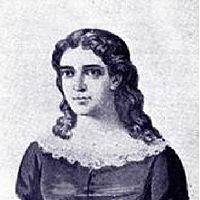
Dolores Veintimilla de Galindo (Quito, 12 de julio de 1829 - Cuenca, 23 de mayo de 1857) fue una poeta ecuatoriana del siglo XIX. Durante su corta vida fue la creadora de poemas de corte romántico que están cargados de elementos que asocian a la mujer con el papel de víctima asociados con sentimientos de dolor, tristeza, anhelo del pasado, amores frustrado y pesimismo. Fue influenciada por la formación de la subjetividad femenina de su época. Su poema “Quejas” está lleno de esos sentimientos que reflejan su estado anímico. El fracaso en su matrimonio con el médico colombiano Sixto Galindo, así como su pensamiento feminista adelantado a la época, marcarían la personalidad y los trabajos posteriores de Dolores. La persecución e incomprensión de la sociedad cuencana la llevó al suicidio.
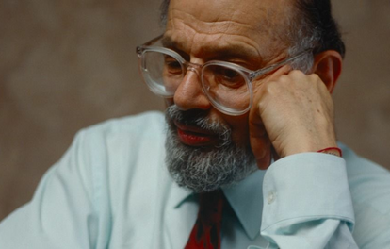
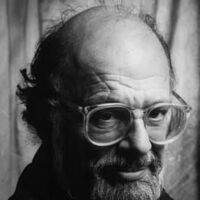
Allen Ginsberg was born on June 3, 1926, in Newark, New Jersey. The son of Louis and Naomi Ginsberg, two Jewish members of the New York literary counter-culture of the 1920s, Ginsberg was raised among several progressive political perspectives. A supporter of the Communist party, Ginsberg's mother was a nudist whose mental health was a concern throughout the poet's childhood. According to biographer Barry Miles, "Naomi's illness gave Allen an enormous empathy and tolerance for madness, neurosis, and psychosis." As an adolescent, Ginsberg savored Walt Whitman, though in 1939, when Ginsberg graduated high school, he considered Edgar Allan Poe his favorite poet. Eager to follow a childhood hero who had received a scholarship to Columbia University, Ginsberg made a vow that if he got into the school he would devote his life to helping the working class, a cause he took seriously over the course of the next several years. He was admitted to Columbia University, and as a student there in the 1940s, he began close friendships with William S. Burroughs, Neal Cassady, and Jack Kerouac, all of whom later became leading figures of the Beat movement. The group led Ginsberg to a "New Vision," which he defined in his journal: "Since art is merely and ultimately self-expressive, we conclude that the fullest art, the most individual, uninfluenced, unrepressed, uninhibited expression of art is true expression and the true art." Around this time, Ginsberg also had what he referred to as his "Blake vision," an auditory hallucination of William Blake reading his poems "Ah Sunflower," "The Sick Rose," and "Little Girl Lost." Ginsberg noted the occurrence several times as a pivotal moment for him in his comprehension of the universe, affecting fundamental beliefs about his life and his work. While Ginsberg claimed that no drugs were involved, he later stated that he used various drugs in an attempt to recapture the feelings inspired by the vision. In 1954, Ginsberg moved to San Francisco. His mentor, William Carlos Williams, introduced him to key figures in the San Francisco poetry scene, including Kenneth Rexroth. He also met Michael McClure, who handed off the duties of curating a reading for the newly-established "6" Gallery. With the help of Rexroth, the result was "The '6' Gallery Reading" which took place on October 7, 1955. The event has been hailed as the birth of the Beat Generation, in no small part because it was also the first public reading of Ginsberg's "Howl," a poem which garnered world-wide attention for him and the poets he associated with. In response to Ginsberg's reading, McClure wrote: "Ginsberg read on to the end of the poem, which left us standing in wonder, or cheering and wondering, but knowing at the deepest level that a barrier had been broken, that a human voice and body had been hurled against the harsh wall of America..." Shortly after Howl and Other Poems was published in 1956 by City Lights Bookstore, it was banned for obscenity. The work overcame censorship trials, however, and became one of the most widely read poems of the century, translated into more than twenty-two languages. In the 1960s and 70s, Ginsberg studied under gurus and Zen masters. As the leading icon of the Beats, Ginsberg was involved in countless political activities, including protests against the Vietnam War, and he spoke openly about issues that concerned him, such as free speech and gay rights agendas. Ginsberg went on to publish numerous collections of poetry, including Kaddish and Other Poems (1961), Planet News (1968), and The Fall of America: Poems of These States (1973), which won the National Book Award. In 1993, Ginsberg received the Chevalier des Arts et des Lettres (the Order of Arts and Letters) from the French Minister of Culture. He also co-founded and directed the Jack Kerouac School of Disembodied Poetics at the Naropa Institute in Colorado. In his later years, Ginsberg became a Distinguished Professor at Brooklyn College. On April 5, 1997, in New York City, he died from complications of hepatitis. Selected Bibliography Poetry * Howl and Other Poems (1956) * Kaddish and Other Poems (1961) * Reality Sandwiches (1963) * The Yage Letters (with William S. Burroughs, 1963) * Planet News (1968) * The Gates of Wrath: Rhymed Poems 1948–1951 (1972) * Iron Horse (1972) * The Fall of America: Poems of These States (1973) * First Blues: Rags, Ballads & Harmonium Songs 1971 - 1974 (1975) * Mind Breaths (1978) * Plutonian Ode: Poems 1977–1980 (1982) * Collected Poems: 1947–1980 (1984) * White Shroud Poems: 1980–1985 (1986) * Cosmopolitan Greetings Poems: 1986–1993 (1994) * Howl Annotated (1995) * Illuminated Poems (1996) * Selected Poems: 1947–1995 (1996) * Death and Fame: Poems 1993–1997 (1999) Prose * Deliberate Prose 1952–1995 (2000) * The Book of Martyrdom and Artifice: First Journals and Poems 1937-1952 (2006) References Poets.org - www.poets.org/poet.php/prmPID/8
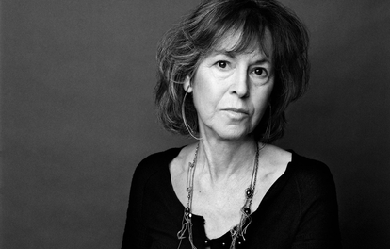
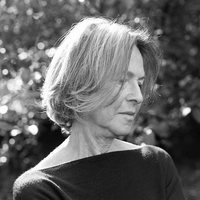
Louise Elisabeth Glück (born April 22, 1943) is an American poet. She was appointed Poet Laureate Consultant in Poetry to the Library of Congress in 2003. Louise was born in New York City of Hungarian Jewish heritage and grew up on Long Island. Her father, Daniel, an immigrant from Hungary, helped invent and market the X-Acto Knife. She graduated in 1961 from George W. Hewlett High School and went on to attend Sarah Lawrence College and later Columbia University; however, she did not graduate from either of them. Glück won the Pulitzer Prize for Poetry in 1993 for her collection The Wild Iris.

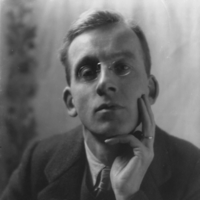
Wilfrid Wilson Gibson (2 October 1878– 26 May 1962) was a British Georgian poet, associated with World War I but also the author of much later work. Early work Gibson was born in Hexham, Northumberland, and left the north for London in 1914 after his mother died. He had been publishing poems in magazines since 1895, and his first collections in book form were published by Elkin Mathews in 1902. His collections of verse plays and dramatic poems The Stonefolds and On The Threshold were published by the Samurai Press (of Cranleigh) in 1907, followed next year by the book of poems, The Web of Life. Despite his residence in London, and later in Gloucestershire, many of Gibson’s poems both then and later, have Northumberland settings: Hexham’s Market Cross; Hareshaw; and The Kielder Stone. Others deal with poverty and passion amid wild Northumbrian landscapes. Still others are devoted to fishermen, industrial workers and miners, often alluding to local ballads and the rich folk-song heritage of the North East. It was in London that he met both Edward Marsh and Rupert Brooke, becoming a close friend and later Brooke’s literary executor (with Lascelles Abercrombie and Walter de la Mare). This was at the period when the first Georgian Poetry anthology was being hatched. Gibson was one of the insiders. During the early part of his writing life, Wilfrid Wilson Gibson wrote poems that featured the “macabre.” One such poem is Flannan Isle, based on a real life mystery. Gibson was one of the founders of the so-called ”Dymock poets”, a community of writers who settled briefly, before the outbreak of the Great War, in the village of Dymock, in north Gloucestershire. Reputation His reputation was eclipsed somewhat by the Ezra Pound-T. S. Eliot school of Modernist poetry; his work remained popular. Further reading Dominic Hibberd, Wilfrid Gibson and Harold Monro, the Pioneers (Cecil Woolf, 2006) References Wikipedia—https://en.wikipedia.org/wiki/Wilfrid_Wilson_Gibson
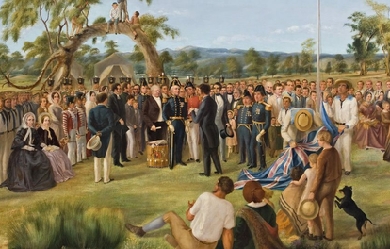
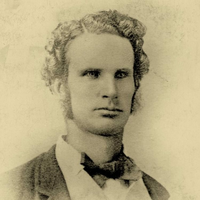
Adam Lindsay Gordon (19 October 1833– 24 June 1870) was an Australian poet, jockey and politician. Early life Gordon was born at Fayal in the Azores, son of Captain Adam Durnford Gordon who had married his first cousin, Harriet Gordon, both of whom were descended from Adam of Gordon of the ballad. Captain Gordon, who had retired from the Bengal cavalry and taught Hindustani, was then staying at the Azores for the sake of his wife’s health. After living on the island of Madeira, they went to England and lived at Cheltenham in 1840. Gordon was sent to Cheltenham College in 1841 when he was only seven, but after he had been there a year he was sent to a school kept by the Rev. Samuel Ollis Garrard in Gloucestershire. He attended the Royal Military Academy, Woolwich in 1848, where he was a contemporary and friend of Charles George Gordon (no relation, later 'Gordon of Khartoum’) and Thomas Bland Strange (later known as “Gunner Jingo”). There Gordon appears to have been good at sports, but not studious and certainly undisciplined– and like Richard Henry Horne, he was asked to leave. Gordon was again admitted a pupil at Cheltenham College. He was not there for long– he appears to have left in the middle of 1852– but the story that he was expelled from Cheltenham is without foundation. Then Gordon was sent to the Royal Grammar School Worcester in 1852. Gordon began to lead a wild and aimless life, contracted debts, and was a great anxiety to his father, who at last decided that his son should go to Australia and make a fresh start in 1853 to join the mounted police with a letter of introduction to the Governor. Gordon had fallen in love with Jane Bridges, a girl of 17 who was able to tell the story 60 years afterwards to his biographers. Gordon did not declare his love until he came to say good-bye to her before leaving for Australia on 7 August 1853. “With characteristic recklessness he offered to sacrifice the passage he had taken to Australia, and all his father’s plans for giving him a fresh start in life, if she would tell him not to go, or promise to be his wife, or even give him some hope.” This she could not do, though she liked the shy handsome boy and remembered him with affection to the end of a long life. It was the one romance of Gordon’s life. That Gordon realised his conduct had fallen much below what it might have been can be seen in his poems... “To my Sister”, written three days before he left England, and “Early Adieux”, evidently written about the same time. To Australia Gordon was just over 20 years old when he arrived in Adelaide on 14 November 1853. He immediately obtained a position in the South Australian mounted police and was stationed at Mount Gambier and Penola. On 4 November 1855 he resigned from the force and took up horse-breaking in the south-eastern district of South Australia. The interest in horse-racing which he had shown as a youth in England was continued in Australia, and in a letter written in November 1854 he mentioned that he had a horse for the steeplechase at the next meeting. In 1857 he met the Rev. Julian Tenison Woods who lent him books and talked poetry with him. He then had the reputation of being “a good steady lad and a splendid horseman”. In this year his father died and he also lost his mother about two years later. From her estate he received £6944–18–1 on 26 October 1861. He was making a reputation as a rider over hurdles, and several times either won or was placed in local hurdle races and steeplechases. On 6 August 1859, the ship Admella ran aground on the Cape Northumberland shoals, not a great distance from where Gordon is known to be staying. The ship broke up, many perished (see main article), and many heroic feats were attempted, including an epic horse ride to Mount Gambier to summon help. Some ten years later, Gordon wrote a poem “The Ride from the Wreck”, probably inspired by this story, but somehow the popular imagination put Gordon in that saddle, and a number of newspaper articles were written to debunk the myth. On 20 October 1862 he married Margaret Park, then a girl of 17. In March 1864 Gordon bought a cottage, Dingley Dell, near Port MacDonnell, and, in this same year, inspired by six engravings after Noel Paton illustrating “The Dowie Dens O’ Yarrow”, Gordon wrote a poem The Feud, of which 30 copies were printed at Mount Gambier. In July 1864 Gordon performed the daring riding feat known as Gordon’s Leap on the edge of the Blue Lake. A commemorative obelisk erected there has an inscription which reads: “This obelisk was erected as a memorial to the famous Australian poet. From near this spot in July, 1864 Gordon made his famed leap on horseback over an old post and rail guard fence onto a narrow ledge overlooking the Blue Lake and jumped back again onto the roadway. The foundation stone of the Gordon Memorial Obelisk was laid on 8th July 1887”. On 11 January 1865 he received a deputation asking him to stand for parliament and was elected by three votes to the South Australian House of Assembly on 16 March 1865 for the district of Victoria. In politics, Gordon was a maverick. His semi-classical speeches were colourful and entertaining but largely irrelevant, and he resigned his seat on 10 November 1866. He found a good friend in wealthy fellow-parliamentarian John Riddoch of Penola, and was a frequent guest at his grand residence “Yallum”. It was there that he wrote The Sick Stockrider. Gordon’s time in politics stimulated him to greater activity– poetry, horse racing and speculation. He was contributing verse to the Australasian and Bell’s Life in Victoria and doing a fair amount of riding. He bought some land in Western Australia, but returned from a visit there early in 1867 and went to live at Mount Gambier. On 10 June 1867 he published “Ashtaroth, a Dramatic Lyric”, and on the nineteenth of the same month “Sea Spray and Smoke Drift”. Move to Victoria With his failures behind him, Gordon turned to Victoria, not to Melbourne which had ignored his poetry, but to Ballarat. In November he rented Craig’s livery stables at Ballarat in partnership with Harry Mount, but he had no head for business and the venture was a failure. In March 1868 he had a serious accident, a horse smashing his head against a gatepost of his own yard. His daughter, born on 3 May 1867, died at the age of 11 months, his financial difficulties were increasing, and he fell into very low spirits. In spite of short sight he was becoming very well known as a gentleman rider, and on 10 October 1868 actually won three races in one day at the Melbourne Hunt Club steeplechase meeting. He rode with great patience and judgment, but his want of good sight was always a handicap. He began riding for money but was not fortunate and had more than one serious fall. He sold his business and left Ballarat in October 1868 and came to Melbourne and eventually found lodgings at 10 Lewis Street, Brighton. He had succeeded in straightening his financial affairs and was more cheerful. He made a little money out of his racing and became a member of the Yorick Club, where he was friendly with Marcus Clarke, George Gordon McCrae, and a little later Henry Kendall. On 12 March 1870 Gordon had a bad fall while riding in a steeplechase at Flemington Racecourse. His head was injured and he never completely recovered. He had for some time been endeavouring to show that he was heir to the estate of Esslemont in Scotland, but there was a flaw in the entail, and in June he learnt that his claim must be abandoned. He had seen his last book, Bush Ballads and Galloping Rhymes, through the press, and it was published on 23 June 1870; it was not successful at the time, but is now regarded as one of the most important pieces of Australian literature. Gordon on that day met Kendall who showed him the proof of the favourable review he had written for the Australasian. But Gordon had just asked his publishers what he owed them for printing the book, and realised that he had no money to pay them and no prospects. He went home to his cottage at 10 Lewis Street Brighton carrying a package of cartridges for his rifle. Next morning he rose early, walked into the tea-tree scrub and shot himself. His wife went back to South Australia, married Peter Low, and lived until November 1919. In October 1870 a monument was erected over his grave at the Brighton General Cemetery by his close friends, and in 1932 a statue to his memory by Paul Montford was unveiled near parliament house, Melbourne; and many other statues and monuments throughout Australia. In May 1934 his bust was placed in Poets’ Corner, Westminster Abbey, being the only Australian poet to have one. Legacy Gordon was tall and handsome (see portrait prefixed to The Laureate of the Centaurs). But he stooped and held himself badly, partly on account of his short sight. He was shy, sensitive and, even before he was overwhelmed with troubles, inclined to be moody. After his head was injured at Ballarat he was never the same man again, and subsequent accidents aggravated his condition. Any suggestion that drink was a contributing cause may be disregarded. Sir Frank Madden, who was with him the day before his death, said that he was then absolutely sober, "he never cared for it [drink] and so far as I know seldom took it at all". The Rev. Tenison Woods in his “Personal Reminiscences” said “Those who did not know Gordon attributed his suicide to drink, but I repeat he was most temperate and disliked the company of drinking men”. Gordon’s death drew much attention to his work and especially in Melbourne the appreciation of it became overdone. This led to a revulsion of feeling among better judges and for a time it was underrated in some quarters. George Bernard Shaw jokes about Gordon’s verse in his play Shakes versus Shav, a dialogue between Shakespeare and himself during which Shakespeare laughs at a line attributed to Gordon. Much of his verse is careless and banal, there are passages in Ashtaroth for instance that are almost unbelievably bad, but at his best he is a poet of importance, who on occasions wrote some magnificent lines. Douglas Sladen, a lifelong admirer, in his Adam Lindsay Gordon, The Westminster Abbey Memorial Volume has made a selection of 27 poems which occupy about 90 pages. Without subscribing to every poem selected it may be said that Gordon is most adequately represented in a sheaf of this kind. His most sustained effort, the “Rhyme of Joyous Garde”, has some glorious stanzas, and on it and some 20 other poems Gordon’s fame may be allowed to rest. One of Gordon’s poems, “The Swimmer”, forms the libretto for the fifth movement of Edward Elgar’s song cycle Sea Pictures, and Elgar also set to music another of his poems, “A Song of Autumn”. After a particularly trying year for the British Royal Family, Elizabeth II quoted from one of Gordon’s more famous poems in her Christmas Message of 1992, “Kindness in another’s trouble, courage in one’s own..”, but did not mention the poet’s name. Dingley Dell, Gordon’s property and home from 1862 to 1866, is preserved as a museum and a conservation park. The museum houses early volumes of his work, personal effects and a display of his horseriding equipment. In 1970 Gordon was honoured on a postage stamp bearing his portrait issued by Australia Post . On 20 September 2014, Gordon was inducted in the Australian Jumps Racing Association’s Gallery of Champions. Selected works * “A Song of Autumn” (1868) * “The Sick Stockrider” (1870) * “The Swimmer” (ca. 1881) References Wikipedia—https://en.wikipedia.org/wiki/Adam_Lindsay_Gordon

Jack Gilbert (February 18, 1925 – November 13, 2012) was an American poet. Born and raised in the Pittsburgh, Pennsylvania neighborhood of East Liberty, he attended Peabody High School then worked as a door-to-door salesman, an exterminator, and a steelworker. He graduated from the University of Pittsburgh in 1954, where he and his classmate Gerald Stern developed a serious interest in poetry and writing. Later, he received his Master's degree from San Francisco State University in 1963. Career His work is distinguished by simple lyricism and straightforward clarity of tone. His first book of poetry, Views of Jeopardy, (1962) won the Yale Younger Poets Prize and was nominated for the Pulitzer Prize, while Gilbert was quickly recognized and made into something of a media darling. He then retreated from his earlier activity in the San Francisco poetry scene, where he had participated in Jack Spicer's Poetry as Magic workshop, and moved to Europe. Living on a Guggenheim Fellowship he toured 15 countries as a lecturer on American Literature for the U.S. State Department and lived in England, Denmark, and Greece. Nearly the whole of his career after the publication of his first book of poetry was marked by what he described as a self-imposed isolation. His books of poetry were few and far between; however he continuously maintained his writing and contributed to The American Poetry Review, Genesis West, The Quarterly, Poetry, Ironwood, The Kenyon Review, and The New Yorker. Personal life Gilbert was a close friend of the poet Linda Gregg who was once his student and with whom he was in a relationship for six years. He was married to Michiko Nogami, another former student and a language instructor based in San Francisco, now deceased, about whom he wrote many of his poems. He was also in a significant long term relationship with the poet Laura Ulewicz during the late fifties and early sixties in San Francisco. Gilbert died on November 13, 2012 in Berkeley, California. He was 87. On April 15, 2013 it was announced that Gilbert's Collected Poems was a finalist for the 2013 Pulitzer Prize in Poetry. The Pulitzer jury's citation read: “a half century of poems reflecting a creative author’s commitment to living fully and honestly and to producing straightforward work that illuminates everyday experience with startling clarity.” Awards 1962 Yale Series of Younger Poets Competition for Views of Jeopardy 1964 Guggenheim Fellowship 1994 Lannan Literary Award for Poetry 1983 Stanley Kunitz Prize for Monolithos 1983 the American Poetry Review Prize for Monolithos 1983 finalist for the Pulitzer Prize for Poetry for Monolithos 2005 National Book Critics Circle Award for Refusing Heaven 2013 finalist for the Pulitzer Prize for Poetry for Collected Poems References Wikipedia - http://en.wikipedia.org/wiki/Jack_Gilbert
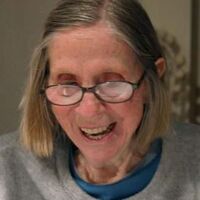
In 1920, Barbara Guest was born in Wilmington, North Carolina. She attended the University of California, Los Angeles, and the University of California, Berkeley, from which she graduated in 1943. Early in her career, she was known predominantly as a writer of the New York School, a group of poets that included John Ashbery, Kenneth Koch, Frank O'Hara, and James Schuyler. The New York School represented a rejection of the dominant school of confessional poetry and was deeply influenced by the action painters of the 1950s and 1960s, particularly Jackson Pollock, Willem de Kooning, and Larry Rivers. Throughout the 1950s, Guest worked as a writer for Art News magazine, and she has continued to write articles and reviews for many art magazines. The tension between the lyrical (or musical) and the graphic (or material) is a defining feature of her work, and her poetry often utilizes space as a way to draw attention to language. Guest has published numerous collections of poetry, among them The Red Gaze (Wesleyan University Press, 2005); Miniatures and Other Poems (2002), Symbiosis (1999), Defensive Rapture (1994), Fair Realism (1989), Musicality (1988), The Nude (1986), Quilts (1980), and Biography (1980). She is also the author of several plays and a novel, Seeking Air (1978). Her honors include the Robert Frost Medal for Distinguished Lifetime Achievement from the Poetry Society of America, the Longwood Award, a San Francisco State award for poetry, the Lawrence Lipton Award for Literature, the Columbia Book Award, and a grant from The National Endowment for the Arts. She lived in Berkeley, California. Guest died on February 15, 2006. A Selected Bibliography Poetry The Blue Stairs (1968) Moscow Mansions (1973) Biography (1980) The Nude (1986) Musicality (1988) Fair Realism (1989) Defensive Rapture (1994) Symbiosis (1999) Miniatures and Other Poems (2002) The Red Gaze (2005) Prose Seeking Air (1978) The Confetti Trees (1999) Rocks on a Platter: Notes on Literature (1999) Plays The Ladies Choice (1953) The Office (1963) Port (1965)
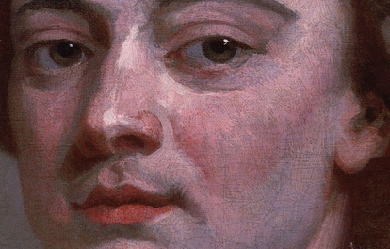

John Gay (/ɡeɪ/; 30 June 1685– 4 December 1732) was an English poet and dramatist and member of the Scriblerus Club. He is best remembered for The Beggar’s Opera (1728), a ballad opera. The characters, including Captain Macheath and Polly Peachum, became household names. Early life Gay was born in Barnstaple, England, and was educated at the town’s grammar school. On leaving school he was apprenticed to a silk mercer in London, but being weary, according to Samuel Johnson, “of either the restraint or the servility of his occupation”, he soon returned to Barnstaple, where he was educated by his uncle, the Rev. John Hanmer, the Nonconformist minister of the town. He then returned to London. Early career The dedication of his Rural Sports (1713) to Alexander Pope was the beginning of a lasting friendship. In 1714, Gay wrote The Shepherd’s Week, a series of six pastorals drawn from English rustic life. Pope had urged him to undertake this task in order to ridicule the Arcadian pastorals of Ambrose Philips, who had been praised by a short-lived contemporary publication The Guardian, to the neglect of Pope’s claims as the first pastoral writer of the age and the true English Theocritus. Gay’s pastorals achieved this goal and his ludicrous pictures of the English country lads and their loves were found to be entertaining on their own account. Gay had just been appointed secretary to the British ambassador to the court of Hanover through the influence of Jonathan Swift when the death of Anne, Queen of Great Britain, three months later put an end to all his hopes of official employment. In 1715, probably with some help from Pope, he produced What d’ye call it?, a dramatic skit on contemporary tragedy, with special reference to Thomas Otway’s Venice Preserv’d. It left the public so ignorant of its real meaning that Lewis Theobald and Benjamin Griffin published a Complete Key to what d’ye call it to explain it. In 1716 appeared his Trivia, or the Art of Walking the Streets of London, a poem in three books, for which he acknowledged having received several hints from Swift. It contains graphic and humorous descriptions of the London of that period. What is most interesting about the poem, however, is not the fact that it depicts the city with photographic accuracy, but that it acts as a guide to the upper, and upper-middle class walkers of society. In taking a mock-heroic form, Gay’s poem was able to poke fun at the notion of complete reformation of street civility, while also proposing an idea of reform in terms of the attitude towards walking. In January 1717 he produced the comedy, Three Hours After Marriage, which was thought to be grossly indecent (without being amusing) and a failure. He had assistance from Pope and John Arbuthnot, but they allowed it to be assumed that Gay was the sole author. Patrons Gay had numerous patrons, and in 1720 he published Poems on Several Occasions by subscription, taking in £1000 or more. In that year James Craggs, the secretary of state, presented him with some South Sea stock. Gay, disregarding the advice of Pope and others of his friends, invested all his money in South Sea stock, and, holding on to the end of the South Sea Bubble, he lost everything. The shock is said to have made him dangerously ill. His friends did not fail him at this juncture. He had patrons in William Pulteney, afterwards Earl of Bath, in the third Earl of Burlington, who constantly entertained him at Chiswick or at Burlington House, and in the third Duke of Queensberry. He was a frequent visitor with Pope, and received unvarying kindness from William Congreve and John Arbuthnot. In 1727 he wrote for six-year-old Prince William, later the Duke of Cumberland, Fifty-one Fables in Verse, for which he naturally hoped to gain some preferment, although he has much to say in them of the servility of courtiers and the vanity of court honours. He was offered the situation of gentleman-usher to the Princess Louisa, who was also still a child. He refused this offer, which all his friends seem to have regarded as an indignity. He had never rendered any special services to the court. The Beggar’s Opera He certainly did nothing to conciliate the favour of the government by his next work, The Beggar’s Opera, a ballad opera produced on the 29 January 1728 by John Rich, in which Sir Robert Walpole was caricatured. This famous piece, which was said to have made “Rich gay and Gay rich”, was an innovation in many respects. The satire of the play has a double allegory. The characters of Peachum and Macheath represent the famous highwayman and gangster Jonathan Wild and the cockney housebreaker Jack Sheppard. At the same time, Macheath was understood to represent Robert Walpole, whose government had been tolerant of Wild’s thievery and the South Sea directors’ escape from punishment. Under cover of the thieves and highwaymen who figured in it was disguised a satire on society, for Gay made it plain that in describing the moral code of his characters he had in mind the corruptions of the governing class. Part of the success of The Beggar’s Opera may have been due to the acting of Lavinia Fenton, afterwards Duchess of Bolton, in the part of Polly Peachum. The play ran for sixty-two nights. Swift is said to have suggested the subject, and Pope and Arbuthnot were constantly consulted while the work was in progress, but Gay must be regarded as the sole author. After seeing an early version of the work, Swift was optimistic of its commercial prospects but famously warned Gay to be cautious with his earnings: “I beg you will be thrifty and learn to value a shilling.” Later career He wrote a sequel, Polly, relating the adventures of Polly Peachum in the West Indies; its production was forbidden by the Lord Chamberlain, no doubt through the influence of Walpole. This act of “oppression” caused no loss to Gay. It proved an excellent advertisement for Polly, which was published by subscription in 1729, and brought its author several thousand pounds. The Duchess of Queensberry was dismissed from court for enlisting subscribers in the palace. The Duke of Queensberry gave Gay a home, and the duchess continued her affectionate patronage until Gay’s death in London on 4 December 1732. He was buried in Westminster Abbey. The epitaph on his tomb is by Pope, and is followed by Gay’s own mocking couplet: Works * Among Gay’s works are: * Wine– 1708 * The Present State of Wit– 1711 * The Rural Sports– 1713 * The Shepherd’s Week– 1714 * The What D’ye Call It– 1715 * Trivia, or The Art of Walking the Streets of London– 1716 * Acis and Galatea– 1718 * Poems on Several Occasions– 1720 * Fables (also known as Fifty-one Fables in Verse or Fables of John Gay)– 1727 (Part the Second– 1738) * The Beggar’s Opera– 1728 * Polly– 1729 * Achilles– 1733 * The Distress’d Wife– 1743 * Three Hours After Marriage– 1717 References Wikipedia—https://en.wikipedia.org/wiki/John_Gay
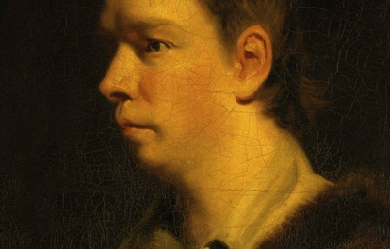

Oliver Goldsmith (10 November 1728– 4 April 1774) was an Irish novelist, playwright and poet, who is best known for his novel The Vicar of Wakefield (1766), his pastoral poem The Deserted Village (1770), and his plays The Good-Natur’d Man (1768) and She Stoops to Conquer (1771, first performed in 1773). He is thought to have written the classic children’s tale The History of Little Goody Two-Shoes (1765). Biography Goldsmith’s birth date and year are not known with certainty. According to the Library of Congress authority file, he told a biographer that he was born on 10 November 1728. The location of his birthplace is also uncertain. He was born either in the townland of Pallas, near Ballymahon, County Longford, Ireland, where his father was the Anglican curate of the parish of Forgney, or at the residence of his maternal grandparents, at the Smith Hill House in the diocese of Elphin, County Roscommon where his grandfather Oliver Jones was a clergyman and master of the Elphin diocesan school, and where Oliver studied. When Goldsmith was two years old, his father was appointed the rector of the parish of “Kilkenny West” in County Westmeath. The family moved to the parsonage at Lissoy, between Athlone and Ballymahon, and continued to live there until his father’s death in 1747. In 1744 Goldsmith went up to Trinity College, Dublin. His tutor was Theaker Wilder. Neglecting his studies in theology and law, he fell to the bottom of his class. In 1747, along with four other undergraduates, he was expelled for a riot in which they attempted to storm the Marshalsea Prison. He was graduated in 1749 as a Bachelor of Arts, but without the discipline or distinction that might have gained him entry to a profession in the church or the law; his education seemed to have given him mainly a taste for fine clothes, playing cards, singing Irish airs and playing the flute. He lived for a short time with his mother, tried various professions without success, studied medicine desultorily at the University of Edinburgh from 1752 to 1755, and set out on a walking tour of Flanders, France, Switzerland and Northern Italy, living by his wits (busking with his flute). He settled in London in 1756, where he briefly held various jobs, including an apothecary’s assistant and an usher of a school. Perennially in debt and addicted to gambling, Goldsmith produced a massive output as a hack writer for the publishers of London, but his few painstaking works earned him the company of Samuel Johnson, with whom he was a founding member of “The Club”. There, through fellow Club member Edmund Burke, he made the acquaintance of Sir George Savile, who would later arrange a job for him at Thornhill Grammar School. The combination of his literary work and his dissolute lifestyle led Horace Walpole to give him the epithet inspired idiot. During this period he used the pseudonym “James Willington” (the name of a fellow student at Trinity) to publish his 1758 translation of the autobiography of the Huguenot Jean Marteilhe. Goldsmith was described by contemporaries as prone to envy, a congenial but impetuous and disorganised personality who once planned to emigrate to America but failed because he missed his ship. At some point around this time he worked at Thornhill Grammar School, later basing Squire Thornhill (in the Vicar of Wakefield) on his benefactor Sir George Savile and certainly spending time with eminent scientist Rev. John Mitchell, who he probably knew from London. Mitchell, sorely missed good company, which Goldsmith naturally provided in spades.Thomas De Quincey wrote of him 'All the motion of Goldsmith’s nature moved in the direction of the true, the natural, the sweet, the gentle’. His premature death in 1774 may have been partly due to his own misdiagnosis of his kidney infection. Goldsmith was buried in Temple Church in London. The inscription reads; "HERE LIES/OLIVER GOLDSMITH". There is a monument to him in the centre of Ballymahon, also in Westminster Abbey with an epitaph written by Samuel Johnson. Works * See The Vicar of Wakefield, The Good-Natur’d Man, The Traveller, and She Stoops to Conquer. The Citizen of the World * In 1760 Goldsmith began to publish a series of letters in the Public Ledger under the title The Citizen of the World. Purportedly written by a Chinese traveller in England by the name of Lien Chi, they used this fictional outsider’s perspective to comment ironically and at times moralistically on British society and manners. It was inspired by the earlier essay series Persian Letters by Charles de Secondat, Baron de Montesquieu. The Hermit * Goldsmith wrote this romantic ballad of precisely 160 lines in 1765. The hero and heroine are Edwin, a youth without wealth or power, and Angelina, the daughter of a lord “beside the Tyne.” Angelina spurns many wooers, but refuses to make plain her love for young Edwin. “Quite dejected with my scorn,” Edwin disappears and becomes a hermit. One day, Angelina turns up at his cell in boy’s clothes and, not recognising him, tells him her story. Edwin then reveals his true identity, and the lovers never part again. The poem is notable for its interesting portrayal of a hermit, who is fond of the natural world and his wilderness solitude but maintains a gentle, sympathetic demeanor toward other people. In keeping with eremitical tradition, however, Edwin the Hermit claims to "spurn the [opposite] sex." This poem appears under the title of “A Ballad” sung by the character of Mr. Burchell in Chapter 8 of Goldsmith’s novel, The Vicar of Wakefield. The Deserted Village * In the 1760s Goldsmith witnessed the demolition of an ancient village and destruction of its farms to clear land to become a wealthy man’s garden. His poem The Deserted Village, published in 1770, expresses a fear that the destruction of villages and the conversion of land from productive agriculture to ornamental landscape gardens would ruin the peasantry. Other works * The Complete Poetical Works of Oliver Goldsmith (ed) Austin Dobson, 1887, kindle ebook March 2011 ASIN B004TP31VM * The ironic poem, An Elegy on the Death of a Mad Dog was published in 1766. * A History of the Earth and Animated Nature (1774) * Goldsmith is also thought to have written the classic children’s tale The History of Little Goody Two-Shoes. Memorials concerning Oliver Goldsmith * Goldsmith lived in Kingsbury, now in North-West London between 1771 and 1774 and Oliver Goldsmith Primary School and Goldsmith Lane there are named after him. * The Oliver Goldsmith Summer School is held every June Bank Holiday at Ballymahon with poetry and creative readings being held at Goldsmith’s birthplace in nearby Pallas, Forgney. * In the play Marx in Soho by Howard Zinn, Marx makes a reference to Goldsmiths’ poem, The Deserted Village. * A statue of him by JH Foley stands at the Front Arch of Trinity College, Dublin (see image). * A statue of him stands in a limestone cell at the ruin of his birthplace in Pallas, Forgney, Ballymahon, County Longford. The statue is a copy of the Foley statue that stands outside Trinity college Dublin and is the focus point of the annual Oliver Goldsmith Summer School. * His name has been given to a new lecture theatre and student accommodation on the Trinity College campus: Goldsmith Hall. * Somerset Maugham used the last line from An Elegy on the Death of a Mad Dog in his novel The Painted Veil (1925). The character Walter Fane’s last words are The dog it was that died. * Auburn, Alabama, and Auburn University were named for the first line in Goldsmith’s poem: “Sweet Auburn, loveliest village of the plain.” Auburn is still referred to as the ‘loveliest village on the plain.’ * There is a statue in Ballymahon County Longford outside the town library by Irish Sculptor Éamonn O’ Doherty (1939 - 2011)which was unveiled in 1999. * London Underground locomotive number 16 (used on the Metropolitan line of the London Underground until 1962) was named Oliver Goldsmith. * Longford based band Goldsmith are named after the famous writer. * Athlone Institute of Technology library is named the Goldsmith Library In popular culture * Two characters in the 1951 comedy The Lavender Hill Mob quote the same line from Goldsmith’s poem “The Traveller”– a subtle joke, because the film’s plot involves the recasting of stolen gold. * During the opening credits of the SKY One adaptation of Sir Terry Pratchett’s Christmas story “The Hogfather”, a portrait of Goldsmith is shown as part of a hall of memorials to those “exhumed” by the “Ankh-Morpork Assassins’ Guild”. References Wikipedia—https://en.wikipedia.org/wiki/Oliver_Goldsmith
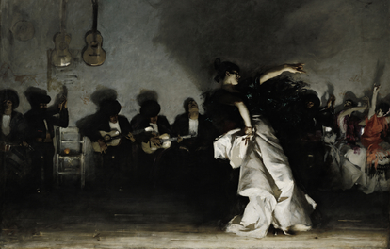
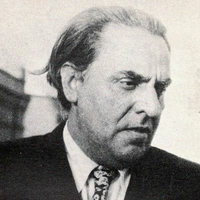
Pedro Garfias Zurita (Salamanca, 20 de mayo de 1901 – Monterrey, México, 9 de agosto de 1967) fue un poeta español de la vanguardia perteneciente a la Generación del 27. Su infancia y juventud transcurrieron en Sevilla y Córdoba. Desde 1918 vivió en Madrid la bohemia literaria al llegar a esta capital para estudiar Leyes, carrera que nunca terminó. Al término de la guerra se exilió, pasó a un campo de concentración francés y luego, en abril de 1939, a Inglaterra, donde vivió en un castillo y empezó a alcoholizarse. Allí compuso su “poema bucólico con intermedios de llanto” titulado Primavera en Eaton Hastings, libro publicado al llegar, el 13 de junio de 1939, al puerto de Veracruz (México), evacuado a bordo del buque francés Sinaia como parte del primer contingente de mil seiscientos veinte republicanos expulsados de su patria. Cantor de Stalin como su prologuista Juan Rejano y demás demócratas defensores de la Cultura, acabó refugiándose en el periodismo y en el alcohol.
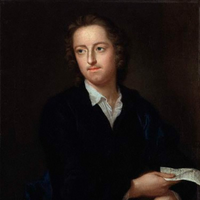
Thomas Gray (26 December 1716– 30 July 1771) was an English poet, letter-writer, classical scholar and professor at Pembroke College, Cambridge. He is widely known for his Elegy Written in a Country Churchyard, published in 1751. Early life and education Thomas Gray was born in Cornhill, London. His father, Philip Gray, was a scrivener and his mother, Dorothy Antrobus, was a milliner He was the fifth of 12 children, and the only child of Philip and Dorothy Gray to survive infancy. He lived with his mother after she left his abusive and mentally unwell father. Gray’s mother paid for him to go to Eton College where two of his uncles worked: Robert and William Antrobus. Robert became Gray’s first teacher and helped inspire in Gray a love for botany and observational science. Gray’s other uncle, William, became his tutor. He recalled his schooldays as a time of great happiness, as is evident in his Ode on a Distant Prospect of Eton College. Gray was a delicate and scholarly boy who spent his time reading and avoiding athletics. He lived in his uncle’s household rather than at college. He made three close friends at Eton: Horace Walpole, son of the Prime Minister Robert Walpole; Thomas Ashton, and Richard West, son of another Richard West who was briefly Lord Chancellor of Ireland. The four prided themselves on their sense of style, sense of humour, and appreciation of beauty. They were called the “quadruple alliance.” In 1734 Gray went up to Peterhouse, Cambridge. He found the curriculum dull. He wrote letters to friends listing all the things he disliked: the masters ("mad with Pride") and the Fellows ("sleepy, drunken, dull, illiterate Things"). Intended by his family for the law, he spent most of his time as an undergraduate reading classical and modern literature, and playing Vivaldi and Scarlatti on the harpsichord for relaxation. In 1738 he accompanied his old school-friend Walpole on his Grand Tour of Europe, possibly at Walpole’s expense. The two fell out and parted in Tuscany, because Walpole wanted to attend fashionable parties and Gray wanted to visit all the antiquities. They were reconciled a few years later. It was Walpole who later helped publish Gray’s poetry. When Gray sent his most famous poem, “Elegy,” to Walpole, Walpole sent off the poem as a manuscript and it appeared in different magazines. Gray then published the poem himself and received the credit he was due Writing and academia Gray began seriously writing poems in 1742, mainly after his close friend Richard West died. He moved to Cambridge and began a self-imposed programme of literary study, becoming one of the most learned men of his time, though he claimed to be lazy by inclination. Gray was a brilliant bookworm, a quiet, abstracted, dreaming scholar, often afraid of the shadows of his own fame. He became a Fellow first of Peterhouse, and later of Pembroke College, Cambridge. Gray moved to Pembroke after the students at Peterhouse played a prank on him. Gray spent most of his life as a scholar in Cambridge, and only later in his life did he begin traveling again. Although he was one of the least productive poets (his collected works published during his lifetime amount to fewer than 1,000 lines), he is regarded as the foremost English-language poet of the mid-18th century. In 1757, he was offered the post of Poet Laureate, which he refused. Gray was so self-critical and fearful of failure that he published only thirteen poems during his lifetime. He once wrote that he feared his collected works would be “mistaken for the works of a flea”. Walpole said that “He never wrote anything easily but things of Humour.” Gray came to be known as one of the “Graveyard poets” of the late 18th century, along with Oliver Goldsmith, William Cowper, and Christopher Smart. Gray perhaps knew these men, sharing ideas about death, mortality, and the finality and sublimity of death. In 1762, the Regius chair of Modern History at Cambridge, a sinecure which carried a salary of £400, fell vacant after the death of Shallet Turner, and Gray’s friends lobbied the government unsuccessfully to secure the position for him. In the event, Gray lost out to Lawrence Brockett, but he secured the position in 1768 after Brockett’s death. “Elegy” masterpiece It is believed that Gray began writing his masterpiece, the Elegy Written in a Country Churchyard, in the graveyard of St Giles parish church in Stoke Poges, Buckinghamshire, in 1742. After several years of leaving it unfinished, he completed it in 1750 (see Elegy for the form). The poem was a literary sensation when published by Robert Dodsley in February 1751 (see 1751 in poetry). Its reflective, calm and stoic tone was greatly admired, and it was pirated, imitated, quoted and translated into Latin and Greek; it is still one of the most popular and most frequently quoted poems in the English language. In 1759 during the Seven Years War, before the Battle of the Plains of Abraham, British General James Wolfe is said to have recited it to his officers, adding: “Gentlemen, I would rather have written that poem than take Quebec tomorrow”. The Elegy was recognised immediately for its beauty and skill. It contains many phrases which have entered the common English lexicon, either on their own or as quoted in other works. These include: “The Paths of Glory” (the title of a 1957 anti-war movie about World War I, produced by and starring Kirk Douglas, and directed by Stanley Kubrick, based on a novel of the same name by Humphrey Cobb). “Celestial fire” “Some mute inglorious Milton” “Far from the Madding Crowd” (the title of a novel by Thomas Hardy, filmed several times) “The unlettered muse” “Kindred spirit” “Elegy” contemplates such themes as death and afterlife. These themes foreshadowed the upcoming Gothic movement. It is suggested that perhaps Gray found inspiration for his poem by visiting the gravesite of his aunt, Mary Antrobus. The aunt was buried at the graveyard by the St. Giles’ churchyard, which he and his mother would visit. This is the same gravesite where Gray himself was later buried. Gray also wrote light verse, including Ode on the Death of a Favourite Cat, Drowned in a Tub of Gold Fishes, a mock elegy concerning Horace Walpole’s cat. After setting the scene with the couplet “What female heart can gold despise? What cat’s averse to fish?”, the poem moves to its multiple proverbial conclusion: “a fav’rite has no friend”, "[k]now one false step is ne’er retrieved" and “nor all that glisters, gold”. (Walpole later displayed the fatal china vase (the tub) on a pedestal at his house in Strawberry Hill.) Gray’s surviving letters also show his sharp observation and playful sense of humour. He is well known for his phrase, “where ignorance is bliss, ’tis folly to be wise.” The phrase, from Ode on a Distant Prospect of Eton College, is possibly one of the most misconstrued phrases in English literature. Gray is not promoting ignorance, but is reflecting with nostalgia on a time when he was allowed to be ignorant, his youth (1742). It has been asserted that the Ode also abounds with images which find “a mirror in every mind”. This was stated by Samuel Johnson who said of the poem, “I rejoice to concur with the common reader... The Church-yard abounds with images which find a mirror in every mind, and with sentiments to which every bosom returns an echo”. Indeed, Gray’s poem follows the style of the mid-century literary endeavor to write of “universal feelings.” Samuel Johnson also said of Gray that he spoke in “two languages”. He spoke in the language of “public” and “private” and according to Johnson, he should have spoken more in his private language as he did in his “Elegy” poem. Forms Gray considered his two Pindaric odes, The Progress of Poesy and The Bard, as his best works. Pindaric odes are to be written with fire and passion, unlike the calmer and more reflective Horatian odes such as Ode on a distant Prospect of Eton College. The Bard tells of a wild Welsh poet cursing the Norman king Edward I after his conquest of Wales and prophesying in detail the downfall of the House of Plantagenet. It is melodramatic, and ends with the bard hurling himself to his death from the top of a mountain. When his duties allowed, Gray travelled widely throughout Britain to places such as Yorkshire, Derbyshire, Scotland and most notably the Lake District (see his Journal of a Visit to the Lake District in 1769) in search of picturesque landscapes and ancient monuments. These elements were not generally valued in the early 18th century, when the popular taste ran to classical styles in architecture and literature, and most people liked their scenery tame and well-tended. Some have seen Gray’s writings on this topic, and the Gothic details that appear in his Elegy and The Bard as the first foreshadowing of the Romantic movement that dominated the early 19th century, when William Wordsworth and the other Lake poets taught people to value the picturesque, the sublime, and the Gothic. Gray combined traditional forms and poetic diction with new topics and modes of expression, and may be considered as a classically focused precursor of the romantic revival. Gray’s connection to the Romantic poets is vexed. In the prefaces to the 1800 and 1802 editions of Wordsworth’s and Samuel Taylor Coleridge’s Lyrical Ballads, Wordsworth singled out Gray’s “Sonnet on the Death of Richard West” to exemplify what he found most objectionable in poetry, declaring it was “Gray, who was at the head of those who, by their reasonings, have attempted to widen the space of separation betwixt prose and metrical composition, and was more than any other man curiously elaborate in the structure of his own poetic diction.” Gray wrote in a letter to West, that “the language of the age is never the language of poetry.” Death Gray died on 30 July 1771 in Cambridge, and was buried beside his mother in the churchyard of St Giles’ church in Stoke Poges, the setting for his famous Elegy. His grave can still be seen there. Honours Gray’s biographer William Mason erected a monument to him, designed by John Bacon the Elder, in Poets’ Corner at Westminster Abbey in 1778. John Penn “of Stoke” had a memorial to Gray built near St Giles’ churchyard and engraved with extracts from the “Elegy”. A plaque in Cornhill marks his birthplace. References Wikipedia—https://en.wikipedia.org/wiki/Thomas_Gray
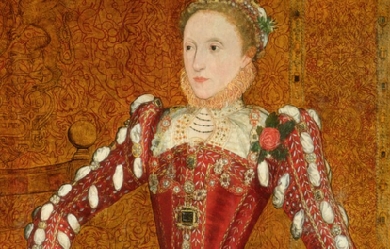
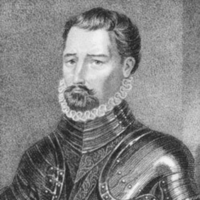
George Gascoigne (c. 1535– 7 October 1577) was an English poet, soldier and unsuccessful courtier. He is considered the most important poet of the early Elizabethan era, following Sir Thomas Wyatt and Henry Howard, Earl of Surrey and leading to the emergence of Philip Sidney. He was the first poet to deify Queen Elizabeth I, in effect establishing her cult as a virgin goddess married to her kingdom and subjects. His most noted works include A Discourse of the Adventures of Master FJ (1573), an account of courtly sexual intrigue and one of the earliest English prose fictions; The Supposes, (performed in 1566, printed in 1573), an early translation of Ariosto and the first comedy written in English prose, which was used by Shakespeare as a source for The Taming of the Shrew; the frequently anthologised short poem “Gascoignes wodmanship” (1573); and “Certayne Notes of Instruction concerning the making of verse or ryme in English” (1575), the first essay on English versification. Early life The eldest son of Sir John Gascoigne of Cardington, Bedfordshire, Gascoigne was educated at Trinity College, Cambridge, and on leaving the university is supposed to have joined the Middle Temple. He became a member of Gray’s Inn in 1555. He has been identified without much show of evidence with a lawyer named Gastone who was in prison in 1548 under very discreditable circumstances. There is no doubt that his escapades were notorious, and that he was imprisoned for debt. George Whetstone says that Sir John Gascoigne disinherited his son on account of his follies, but by his own account he was obliged to sell his patrimony to pay the debts contracted at court. He was M.P. for Bedford in 1557–1558 and 1558–1559, but when he presented himself in 1572 for election at Midhurst he was refused on the charges of being “a defamed person and noted for manslaughter”, “a common Rymer and a deviser of slaunderous Pasquelles”, “a notorious rufilanne”, and a constantly indebted atheist. His poems, with the exception of some commendatory verses, were not published before 1572, but they may have circulated in manuscript before that date. He tells us that his friends at Gray’s Inn importuned him to write on Latin themes set by them, and that two of his plays were acted there. He repaired his fortunes by marrying the wealthy widow of William Breton, thus becoming stepfather to the poet, Nicholas Breton. In 1568 an inquiry into the disposition of William Breton’s property with a view to the protection of the children’s rights was instituted before the Lord Mayor, but the matter was probably settled in a friendly manner, for Gascoigne continued to hold the Breton Walthamstow estate, which he had from his wife, until his death. Plays at Grays Inn Gascoigne translated two plays performed in 1566 at Grays Inn, the most aristocratic of the Renaissance London Inns of Court: the prose comedy Supposes based on Ariosto’s Suppositi, and Jocasta, a tragedy in blank verse which is said to have derived from Euripides’s Phoenissae, but appears more directly as a translation from the Italian of Lodovico Dolce’s Giocasta. Hundredth Sundry Flowres (1573) and Posies of Gascoigne (1575) Gascoigne’s best known and controversial work was originally published in 1573 under the title A Hundredth Sundry Flowres bound up in one small Posie. Gathered partly (by translation) in the fyne outlandish Gardens of Euripides, Ovid, Petrarch, Ariosto and others; and partly by Invention out of our owne fruitfull Orchardes in Englande, Yelding Sundrie Savours of tragical, comical and moral discourse, bothe pleasaunt and profitable, to the well-smelling noses of learned readers, by London printer Richarde Smith. The book purports to be an anthology of courtly poets, gathered and edited by Gascoigne and two other editors known only by the initials “H.W.” and “G.T.” The book’s content is throughout suggestive of courtly scandal, and the aura of scandal is skillfully elaborated through the effective use of initials and posies—Latin or English tags supposed to denote particular authors—in place of the real names of actual or alleged authors. For reasons that are still unclear, the book was republished, with certain additions and deletions, two years later under the alternative title, The Posies of George Gascoigne, Esquire. The new edition contains three new dedicatory epistles, signed by Gascoigne, which apologize for some offense that the original edition had caused and effect to transfer sole responsibility for the book’s content to Gascoigne himself. At war in the Netherlands When Gascoigne sailed as a soldier of fortune to the Low Countries in 1572, his ship was driven by stress of weather to Brielle, which luckily for him had just fallen into the hands of the Dutch. He obtained a captain’s commission, and took an active part in the campaigns of the next two years including the Middelburg siege, during which he acquired a profound dislike of the Dutch, and a great admiration for William of Orange, who had personally intervened on his behalf in a quarrel with his colonel, and secured him against the suspicion caused by his clandestine visits to a lady at the Hague. Taken prisoner after the evacuation of Valkenburg by English troops during the Siege of Leiden, he was sent to England in the autumn of 1574. He dedicated to Lord Grey de Wilton the story of his adventures, The Fruites of Warres (printed in the edition of 1575) and Gascoigne’s Voyage into Hollande. In 1575 he had a share in devising the masques, published in the next year as The Princely Pleasures at the Courte at Kenelworth, which celebrated the queen’s visit to the Earl of Leicester. At Woodstock in 1575 he delivered a prose speech before Elizabeth, and was present at a reading of the Pleasant Tale of Hemetes the Hermit, a brief romance, probably written by the queen’s host, Sir Henry Lee. At the queen’s annual gift exchange with members of her court the following New Year’s, Gascoigne gave her a manuscript of Hemetes which he had translated into Latin, Italian, and French. Its frontispiece shows the Queen rewarding the kneeling poet with an accolade and a purse; its motto, “Tam Marti, quam Mercurio,” indicates that he will serve her as a soldier, as a scholar-poet, or as both. He also drew three emblems, with accompanying text in the three other languages. He also translated Jacques du Fouilloux’s La Venerie (1561) into English as The Noble Arte of Venerie or Hunting (1575) which was printed together with George Turberville’s The Book of Falconrie or Hawking and is thus sometimes misattributed to Turberville though in fact it was a work by Gascoigne. Later writings and influences Most of his works were published during the last years of his life after his return from the wars. He died 7 October 1577 at Walcot Hall, Barnack, near Stamford, where he was the guest of George Whetstone and was buried in the Whetstone family vault at St John the Baptist’s Church, Barnack. Gascoigne’s theory of metrical composition is explained in a short critical treatise, “Certayne Notes of Instruction concerning the making of verse or ryme in English, written at the request of Master Edouardo Donati,” prefixed to his Posies (1575). He acknowledged Chaucer as his master, and differed from the earlier poets of the school of Surrey and Wyatt chiefly in the greater smoothness and sweetness of his verse. Ancestry References Wikipedia—https://en.wikipedia.org/wiki/George_Gascoigne
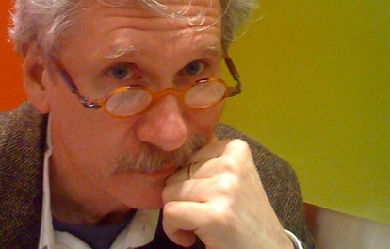
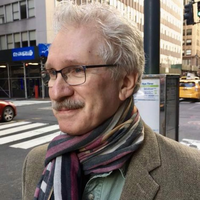
Reginald Gibbons (born 1947) is an American poet, fiction writer, translator, literary critic, and Professor of English and Classics at Northwestern University and Director of the Center for the Writing Arts there. Gibbons has published numerous books, as well as poems, short stories, essays and reviews in journals and magazines, has held Guggenheim Foundation and NEA fellowships in poetry and a research fellowship from the Center for Hellenic Studies in Washington D.C. He has won the Anisfield-Wolf Book Award, the Carl Sandburg Prize, the Folger Shakespeare Library’s O. B. Hardison, Jr. Poetry Prize, and other honors, among them the inclusion of his work in Best American Poetry and Pushcart Prize anthologies. His book Creatures of a Day was a finalist for the 2008 National Book Award for poetry. He attended public school in Spring Branch (at that time, outside Houston, Texas; now incorporated into the city), Princeton University (BA Spanish and Portuguese), and Stanford University (MA in English and Creative Writing; PhD in Comparative Literature). Before moving to Northwestern University, he taught creative writing at Princeton and Columbia. At Northwestern, he was the editor of TriQuarterly magazine from 1981 to 1997, and co-founded TriQuarterly Books (after 1997, an imprint of Northwestern University Press). As the editor of TriQuarterly, he edited or co-edited the special issues Chicago (1984), From South Africa: New Writing, Photography and Art (1987), A Window on Poland (1983), Prose from Spain (1983), New Writing from Mexico (1992), and others, as well as many general issues of the magazine. He edited two works of William Goyen (1915-1983): the 50th Anniversary edition of The House of Breath and the Goyen’s posthumously published second novel, Half a Look of Cain (both published by Northwestern University Press). In 1989, he was one of a group of co-founders of the Guild Literary Complex (Chicago), a literary presenting organization, where he continues to volunteer, and he is a member of the large team that is creating the American Writers Museum (Chicago; opening in 2017). Career * Lecturer in creative writing, Princeton University (Princeton, NJ), 1976-1980 * Lecturer in creative writing, Columbia University School of General Studies, 1980-81 * Professor of English, Northwestern University (Evanston, IL), 1981- * Editor of TriQuarterly magazine, 1981-1997 * Core faculty member of MFA Program for Writers, Warren Wilson College (Asheville, NC), 1989-2011 * Co-founder and member of the board of directors, Guild Complex, 1989- * Member, National Advisory Council and Content Leadership Team, American Writers Museum, 2012- Poetry * Roofs Voices Roads. (Quarterly Review of Literature, 1979). * The Ruined Motel. (Houghton, 1981). * Saints. (Persea Books, 1986). * Maybe It Was So. (University of Chicago Press, 1991). ISBN 978-0-226-29056-0 * Sparrow: New and Selected Poems. (LSU Press, 1997). ISBN 978-0-8071-2232-7 * Homage to Longshot O’Leary: Poems. (Holy Cow! Press, 1999). * It’s Time: Poems. (LSU Press, 2002). ISBN 978-0-8071-2815-2 * Creatures of a Day: Poems. (LSU Press, 2008). ISBN 978-0-8071-3318-7 * Desde una barca de papel (Poemas 1981-2008). (Littera Libros (Villanueva de la Serena, SPAIN), 2009. (Bilingual edition) * Slow Trains Overhead: Chicago Poems and Stories. (University of Chicago Press, 2010). ISBN 978-0-226-29058-4 * L’abitino blue. (Gattomerlino (Rome, ITALY). (Bilingual edition) * Last Lake. (University of Chicago Press, 2016. ISBN 978-0-226-41745-5 Fiction * Sweetbitter: A Novel. (LSU Press, 2003). ISBN 978-0-8071-2871-8 * Five Pears or Peaches. (Broken Moon Press, 1991). * Orchard in the Street. (BOA Editions, Ltd, forthcoming 2017). Other Books * Sophocles, Selected Poems: Odes and Fragments (Princeton University Press, 2008.) Translated and Introduced by Reginald Gibbons. ISBN 978-0-691-13024-8 * How Poems Think (University of Chicago Press, 2015). ISBN 978-0-226-27800-1 * Sophocles, Antigone (Oxford University Press, 2007). Translated by Reginald Gibbons and Charles Segal. ISBN 978-0-19514310-2 * Goyen: Autobiographical Essays, Notesbooks, Evocations, Interviews, by William Goyen (University of Texas Press, 2007. ISBN 978-0-292-72225-5 * The Complete Sophocles, Volume I: The Theban Plays (Oxford University Press, 2011.) Antigone translated by Reginald Gibbons and Charles Segal. ISBN 978-0-19-538880-0 * The Complete Euripides, Volume IV: Bacchae and Other Plays (Oxford University Press, 2009.) Bacchae translated by Reginald Gibbons and Charles Segal. ISBN 978-0-19-537340-0 * New Writing from Mexico, edited by Reginald Gibbons. TriQuarterly Books, 1992. * Thomas McGrath: Life and the Poem, edited by Reginald Gibbons and Terrence Des Press. (University of Illinois Press, 1992. ISBN 0-252-06177-2 References Wikipedia—https://en.wikipedia.org/wiki/Reginald_Gibbons

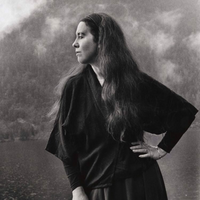
Tess Gallagher (born July 21, 1943 in Port Angeles, Washington) is an American poet, essayist, and short story writer. She attended the University of Washington, where she studied creative writing with Theodore Roethke and later Nelson Bentley as well as David Wagoner and Mark Strand. Her honors include a fellowship from the Guggenheim Foundation, two National Endowment for the Arts awards, the The Maxine Cushing Gray Endowed Libraries Visiting Writers Fellowship (University of Washington), and the Elliston Award for “best book of poetry published by a small press” for the collection Instructions to the Double (1976). Her late husband, Raymond Carver, encouraged her to write short stories, some of which were collected in The Lover of Horses (1987) and At the Owl Woman Saloon (1996). Her book Moon Crossing Bridge is a collection of love poems written for Carver after his death from cancer in 1988. “Moon Crossing Bridge” was followed in 2002 by the collection “Dear Ghosts.” Gallagher has taught at many colleges, most recently at Bucknell University and Whitman College. In December 2006, she published an essay in The Sun Magazine, titled “Instead of Dying”, about alcoholism and Raymond Carver’s having maintained his sobriety. The essay is an adaptation of a talk she initially delivered at the Welsh Academy’s Academi Intoxication Conference in 2006. The first lines read: “Instead of dying from alcohol, Raymond Carver chose to live. I would meet him five months after this choice, so I never knew the Ray who drank, except by report and through the characters and actions of his stories and poems.” Distant Rain, published in 2006, is a conversation between Tess and Jakuchō Setouchi, a Buddhist nun from Kyoto, which took place after Carver’s death.
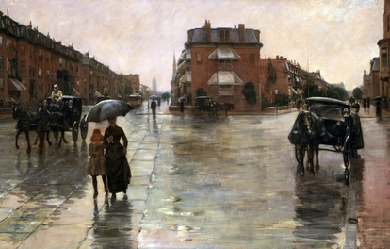
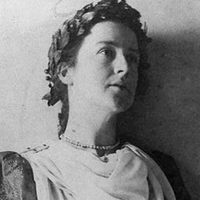
Louise Imogen Guiney (January 7, 1861– November 2, 1920) was an American poet, essayist and editor, born in Roxbury, Massachusetts. The daughter of Gen. Patrick R. Guiney, an Irish-born American Civil War officer and lawyer, and Jeannette Margaret Doyle, she was educated at a convent school in Providence, Rhode Island, from which she graduated in 1879. Over the next 20 years, she worked at various jobs, including serving as a postmistress and working as a cataloger at the Boston Public Library.

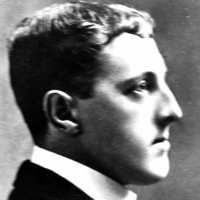
Norman Rowland Gale (4 March 1862– 7 October 1942) was a poet, story-teller and reviewer, who published many books over a period of nearly fifty years. His best-known poem is probably The Country Faith, which is in the Oxford Book of English Verse. Publications * A Country Muse (2 vols.), 1892 * Orchard Songs, 1893 * A June Romance, 1894 * All Expenses Paid, 1895 * Cricket Songs, 1894 * Songs for Little People, 1896 * (ed.) Poems by John Clare, 1901 * Barty’s Star, 1903 * More Cricket Songs, 1905 * A Book of Quatrains, 1909 * Song in September, 1912 * Solitude, 1913 * Collected Poems, 1914 * The Candid Cuckoo, 1918 * A Merry-go-Round of Song, 1919 * Verse in Bloom, 1925 * A Flight of Fancies, 1926 * Messrs Bat and Ball, 1930 * Close of Play, 1936 * Remembrances, 1937 * Love-in-a-Mist, 1939 References Wikipedia—https://en.wikipedia.org/wiki/Norman_Gale
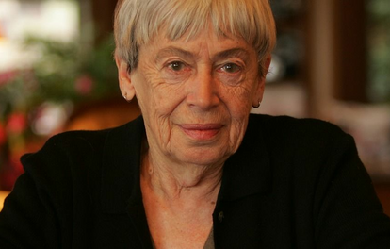
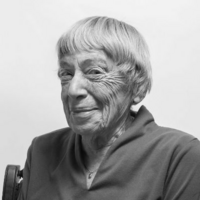
Ursula Kroeber Le Guin (October 21, 1929 – January 22, 2018) was an American novelist. She worked mainly in the genres of fantasy and science fiction. She also authored children’s books, short stories, poetry, and essays. Her writing was first published in the 1960s and often depicted futuristic or imaginary alternative worlds in politics, the natural environment, gender, religion, sexuality, and ethnography. In 2016, The New York Times described her as “America’s greatest living science fiction writer”, although she said that she would prefer to be known as an “American novelist”. She influenced Booker Prize winners and other writers, such as Salman Rushdie and David Mitchell, and science fiction and fantasy writers including Neil Gaiman and Iain Banks. She won the Hugo Award, Nebula Award, Locus Award, and World Fantasy Award, each more than once. In 2014, she was awarded the National Book Foundation Medal for Distinguished Contribution to American Letters. In 2003, she was made a Grandmaster of Science Fiction, one of a few women writers to take the top honor in the genre. Life Birth and family Ursula Kroeber was the daughter of anthropologist Alfred Louis Kroeber of the University of California, Berkeley, and writer Theodora Kracaw. Childhood and education Ursula and her three older brothers, Clifton, Theodore, and Karl Kroeber, were encouraged to read and were exposed to their parents’ dynamic friend group, which included Native Americans and Robert Oppenheimer, who was later to become in part a model for her hero in The Dispossessed. Le Guin stated that, in retrospect, she was grateful for the ease and happiness of her upbringing. The encouraging environment fostered Le Guin’s interest in literature; her first fantasy story was written at age 9, her first science fiction story submitted for publication in the magazine Astounding Science Fiction at age 11. The family spent the academic year in Berkeley, retreating in the summers to “Kishamish” in Napa Valley, "an old, tumble-down ranch... [and] a gathering place for scientists, writers, students, and California Indians. Even though I didn’t pay much attention, I heard a lot of interesting, grown-up conversation." She was interested in biology and poetry, but found math difficult. Le Guin attended Berkeley High School. She received her B.A. (Phi Beta Kappa) in Renaissance French and Italian literature from Radcliffe College in 1951, and M.A. in French and Italian literature from Columbia University in 1952. Soon after, Le Guin began her Ph.D. work and won a Fulbright grant to continue her studies in France from 1953 to 1954. Marriage and family In 1953, while traveling to France aboard the Queen Mary, Le Guin met her future husband, historian Charles Le Guin. They married later that year in Paris. After marrying, Le Guin chose not to continue her doctoral studies of the poet Jean Lemaire de Belges. The couple returned to the United States so that he could pursue his Ph.D. at Emory University. During this time, she worked as a secretary and taught French at the university level. Their first child, Elisabeth (1957), was born in Moscow, Idaho, where Charles taught. In 1958 the Le Guins moved to Portland, Oregon, where their daughter Caroline (1959) was born, and where they lived thereafter. Charles is Emeritus Professor of History at Portland State University. During this time, she continued to make time for writing in addition to maintaining her family life. In 1964, her third child, Theodore, was born. Death Le Guin died on January 22, 2018, at her home in Portland, Oregon; her son stated that she had been in poor health for several months. Her New York Times obituary called her “the immensely popular author who brought literary depth and a tough-minded feminist sensibility to science fiction and fantasy with books like The Left Hand of Darkness and the Earthsea series”. Writing career Le Guin became interested in literature quite early. At age 11, she submitted her first story to the magazine Astounding Science Fiction. Despite being rejected, she continued writing but did not attempt to publish for the next ten years. From 1951 to 1961 she wrote five novels, which publishers rejected, because they seemed inaccessible. She also wrote poetry during this time, including Wild Angels (1975). Her earliest writings, some of which she adapted in Orsinian Tales and Malafrena, were non-fantastic stories set in the imaginary country of Orsinia. Searching for a way to express her interests, she returned to her early interest in science fiction; in the early 1960s her work began to be published regularly. One Orsinian Tale was published in the Summer 1961 issue of The Western Humanities Review and three of her stories appeared in 1962 and 1963 numbers of Fantastic Stories of Imagination, a monthly edited by Cele Goldsmith. Goldsmith also edited Amazing Stories, which ran two of Le Guin’s stories in 1964, including the first “Hainish” story. In 1964 the short story “The Word of Unbinding” was published. This was the first of the Earthsea fantasy series, which includes six books and eight short stories. The three linked young adult novels beginning with A Wizard of Earthsea (1968), The Tombs of Atuan (1970), and The Farthest Shore (1972), sometimes referred to as The Earthsea Trilogy, in later years would be joined by the books Tehanu, Tales from Earthsea and The Other Wind. Le Guin received wide recognition for her novel The Left Hand of Darkness, which won the Hugo and Nebula awards in 1970. Her subsequent novel The Dispossessed made her the first person to win both the Hugo and Nebula Awards for Best Novel twice for the same two books. In later years, Le Guin worked in film and audio. She contributed to The Lathe of Heaven, a 1979 PBS film based on her novel of the same name. In 1985 she collaborated with avant-garde composer David Bedford on the libretto of Rigel 9, a space opera. In May 1983 she delivered a well-received commencement address entitled “A Left-Handed Commencement Address” at Mills College, Oakland, California. “A Left-Handed Commencement Address” is included in her nonfiction collection Dancing at the Edge of the World. In 1984, Le Guin was part of a group along with Ken Kesey, Brian Booth, and William Stafford that founded the Oregon Institute of Literary Arts, which is now known as Literary Arts in Portland. In December 2009, Le Guin resigned from the Authors Guild in protest over its endorsement of Google Books, Google’s book digitization project. “You decided to deal with the devil”, she wrote in her resignation letter. “There are principles involved, above all the whole concept of copyright; and these you have seen fit to abandon to a corporation, on their terms, without a struggle.” (See Authors Guild, Inc. v. Google, Inc..) Influences Le Guin was influenced by fantasy writers, including J. R. R. Tolkien, by science fiction writers, including Philip K. Dick (who was in her high school class, though they did not know each other), by central figures of Western literature such as Leo Tolstoy, Virgil and the Brontë sisters, by feminist writers such as Virginia Woolf, by children’s literature such as Alice in Wonderland, The Wind in the Willows, The Jungle Book, by Norse mythology, and by books from the Eastern tradition such as the Tao Te Ching. When asked about her influences, she replied: Once I learned to read, I read everything. I read all the famous fantasies – Alice in Wonderland, and Wind in the Willows, and Kipling. I adored Kipling’s Jungle Book. And then when I got older I found Lord Dunsany. He opened up a whole new world – the world of pure fantasy. And... Worm Ouroboros. Again, pure fantasy. Very, very fattening. And then my brother and I blundered into science fiction when I was 11 or 12. Early Asimov, things like that. But that didn’t have too much effect on me. It wasn’t until I came back to science fiction and discovered Sturgeon – but particularly Cordwainer Smith.... I read the story “Alpha Ralpha Boulevard”, and it just made me go, “Wow! This stuff is so beautiful, and so strange, and I want to do something like that.” In the mid-1950s, she read J. R. R. Tolkien’s The Lord of the Rings, which had an enormous impact on her. But rather than making her want to follow in Tolkien’s footsteps, it simply showed her what was possible with the fantasy genre. Themes Le Guin exploits the creative flexibility of the science fiction and fantasy genres to undertake thorough explorations of dimensions of both social and psychological identity and of broader cultural and social structures. In doing so, she draws on sociology, anthropology, and psychology, leading some critics to categorize her work as soft science fiction. She objected to this classification of her writing, arguing the term is divisive and implies a narrow view of what constitutes valid science fiction. Underlying ideas of anarchism and environmentalism also make repeated appearances throughout Le Guin’s work. In 2014 Le Guin said about the appeal of contemplating possible futures in science fiction: anything at all can be said to happen [in the future] without fear of contradiction from a native. The future is a safe, sterile laboratory for trying out ideas in, a means of thinking about reality, a method. Sociology, anthropology and psychology Being so thoroughly informed by social science perspectives on identity and society, Le Guin treats race and gender quite deliberately. The majority of her main characters are people of color, a choice made to reflect the non-white majority of humans, and one to which she attributes the frequent lack of character illustrations on her book covers. Her writing often makes use of alien (i.e., human but non-Terran) cultures to examine structural characteristics of human culture and society and their impact on the individual. This prominent theme of cultural interaction is most likely rooted in the fact that Le Guin grew up in a household of anthropologists where she was surrounded by the remarkable case of Ishi – a Native American acclaimed in his time as the “last wild Indian” – and his interaction with the white man’s world. Le Guin’s father was director of the University of California Museum of Anthropology, where Ishi was studied and worked as a research assistant. Her mother wrote the bestseller Ishi in Two Worlds. Similar elements are echoed through many of Le Guin’s stories – from Planet of Exile and City of Illusions to The Word for World Is Forest and The Dispossessed. Le Guin’s writing notably employs the ordinary actions and transactions of everyday life, clarifying how these daily activities embed individuals in a context of relation to the physical world and to one another. For example, the engagement of the main characters with the everyday business of looking after animals, tending gardens and doing domestic chores is central to the novel Tehanu. Themes of Jungian psychology also are prominent in her writing. For example Le Guin’s Hainish Cycle, a series of novels encompassing a loose collection of societies, of various related human species, that exist largely in isolation from one another, providing the setting for her explorations of intercultural encounter. The Left Hand of Darkness, The Dispossessed and The Telling all consider the consequences of contact between different worlds and cultures. Unlike those in much mainstream science fiction, Hainish Cycle civilization does not possess reliable human faster-than-light travel, but does have technology for instantaneous communication. The social and cultural impact of the arrival of Ekumen envoys (known as “mobiles”) on remote planets, and the culture shock that the envoys experience, constitute major themes of The Left Hand of Darkness. Le Guin’s concept has been borrowed explicitly by several other well-known authors, to the extent of using the name of the communication device (the “ansible”). The Left Hand of Darkness is particularly noted for the way she explores social, cultural, and personal consequences of sexual identity through a novel involving a human’s encounter with an intermittently androgynous race. In addition to androgyny, Le Guin’s focus on sexuality breaks down normative gender roles. “Solitude”, one of the stories in The Birthday of the World: and Other Stories follows a young girl, more adventurous and daring than her older brother, into a world dominated by strong, territorial women. In Paradises Lost, the people of a spaceship several generations into the voyage to a new colony-world are saved by a female interstellar navigator, an archetypal role typically reserved for men. Environmentalism Elizabeth McDowell states in her 1992 master’s thesis that Le Guin "identif[ies] the present dominant socio-political American system as problematic and destructive to the health and life of the natural world, humanity, and their interrelations". This idea recurs in several of Le Guin’s works, most notably The Left Hand of Darkness (1969), The Word for World Is Forest (1972), The Dispossessed (1974), The Eye of the Heron (1978), Always Coming Home (1985), and “Buffalo Gals, Won’t You Come Out Tonight” (1987). All of these works center on ideas regarding socio-political organization and value-system experiments in both utopias and dystopias. As McDowell explains, “Although many of Le Guin’s works are exercises in the fantastic imagination, they are equally exercises of the political imagination.” In addition to her fiction, Le Guin’s book Out Here: Poems and Images from Steens Mountain Country, a collaboration with artist Roger Dorband, is a clear environmental testament to the natural beauty of that area of Eastern Oregon. Le Guin also wrote several works of poetry and nonfiction on Mount St. Helens following the 1980 eruption. These works explore local stories and discussions surrounding the eruption event in conjunction with Le Guin’s own perspective as it relates to viewing the eruption and mountain from her home in Portland, as well as her various visits into the blast zone. Anarchism and Taoism Le Guin’s feelings towards anarchism were closely tied to her Taoist beliefs and both ideas appear in her work. “Taoism and Anarchism fit together in some very interesting ways and I’ve been a Taoist ever since I learned what it was.” She participated in numerous peace marches and although she did not call herself an anarchist, since she did not live the lifestyle, she did feel that “Democracy is good but it isn’t the only way to achieve justice and a fair share.” Le Guin said: “The Dispossessed is an Anarchist utopian novel. Its ideas come from the Pacifist Anarchist tradition – Kropotkin etc. So did some of the ideas of the so-called counterculture of the sixties and seventies.” She also said that anarchism “is a necessary ideal at the very least. It is an ideal without which we couldn’t go on. If you are asking me is anarchism at this point a practical movement, well, then you get in the question of where you try to do it and who’s living on your boundary?” Le Guin has been credited with helping to popularize anarchism as her work "rescues anarchism from the cultural ghetto to which it has been consigned [and] introduces the anarchist vision... into the mainstream of intellectual discourse". Indeed her works were influential in developing a new anarchist way of thinking; a postmodern way that is more adaptable and looks at/addresses a broader range of concerns. Adaptations of her work Few of Le Guin’s major works have been adapted for film or television. Her 1971 novel The Lathe of Heaven has been adapted twice: The first adaptation was made in 1979 by WNET Channel 13 in New York, with her own participation, and the second adaptation was made in 2002 by the A&E Network. In a 2008 interview, she said she considers the 1979 adaptation as “the only good adaptation to film” of her work to date. In the early 1980s animator and director Hayao Miyazaki asked permission to create an animated adaptation of Earthsea. However, Le Guin, who was unfamiliar with his work and anime in general, turned down the offer. Years later, after seeing My Neighbor Totoro, she reconsidered her refusal, believing that if anyone should be allowed to direct an Earthsea film, it should be Hayao Miyazaki. The third and fourth Earthsea books were used as the basis of the 2006 animated film Tales from Earthsea (ゲド戦記, Gedo Senki). The film, however, was directed by Miyazaki’s son, Gorō, rather than Hayao Miyazaki himself, which disappointed Le Guin. While she was positive about the aesthetic of the film, writing that “much of it was beautiful”, she took great issue with its re-imagining of the moral sense of the books and greater focus on physical violence. "[E]vil has been comfortably externalized in a villain", Le Guin writes, "the wizard Kumo/Cob, who can simply be killed, thus solving all problems. In modern fantasy (literary or governmental), killing people is the usual solution to the so-called war between good and evil. My books are not conceived in terms of such a war, and offer no simple answers to simplistic questions.” In 1987, the CBC Radio anthology program Vanishing Point adapted The Dispossessed into a series of six 30-minute episodes, and at an unspecified date The Word for World Is Forest as a series of three 30-minute episodes. In 1995, Chicago’s Lifeline Theatre presented its adaptation of The Left Hand of Darkness. Reviewer Jack Helbig at the Chicago Reader wrote that the “adaptation is intelligent and well crafted but ultimately unsatisfying”, in large measure because it is extremely difficult to compress a complex 300-page novel into a two-hour stage presentation. In 2004 the Sci Fi Channel adapted the first two books of the Earthsea trilogy as the miniseries Legend of Earthsea. Le Guin was highly critical of the adaptation, calling it a “far cry from the Earthsea I envisioned”, objecting both to the use of white actors for her red, brown, or black-skinned characters, and to the way she was “cut out of the process”. Her novella, Paradises Lost, published in The Birthday of the World: and Other Stories, was adapted into an opera by the American composer Stephen Andrew Taylor and Canadian librettist Marcia Johnson. The opera premiered April 26, 2012 at the Krannert Center for the Performing Arts on the campus of the University of Illinois. In 2013, the Portland Playhouse and Hand2Mouth Theatre produced a stage adaptation of The Left Hand of Darkness, directed and adapted by Jonathan Walters, with text adapted by John Schmor. The play opened May 2, 2013, and ran until June 16, 2013, in Portland, Oregon. In 2015, the BBC commissioned radio adaptations of The Left Hand of Darkness and the first three Earthsea novels. The Left Hand of Darkness was aired as two hour-long episodes, and Earthsea as six half-hour episodes. In early 2017 Le Guin’s award winning novel The Left Hand of Darkness was picked up by Critical Content, a production company formerly known as Relativity Television, to be produced as a television limited series. Le Guin was to serve as a consulting producer on the project.

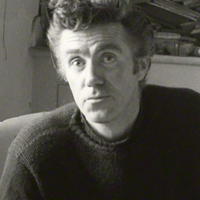
William Sydney Graham (19 November 1918– 9 January 1986) was a Scottish poet who is often associated with Dylan Thomas and the neo-romantic group of poets. Graham’s poetry was mostly overlooked in his lifetime but, partly due to the support of Harold Pinter, his work has enjoyed a revival in recent years. He was represented in the second edition of the Penguin Book of Contemporary Verse (Harmondsworth, UK, 1962) and the Anthology of Twentieth-Century British and Irish Poetry (Oxford University Press, 2001). Early life and work Graham was born in Greenock. In 1932, he left school to become an apprentice draughtsman and then studied structural engineering at Stow College, Glasgow. He was awarded a bursary to study literature for a year at Newbattle Abbey College in 1938. Graham spent the war years working at a number of jobs in Scotland and Ireland before moving to Cornwall in 1944. His first book, Cage Without Grievance was published in 1942. Graham and the neo-romantics The 1940s were prolific years for Graham, and he published four more books during that decade. These were The Seven Journeys (1944)' 2ND Poems (1945), The Voyages of Alfred Wallis (1948) and The White Threshold (1949). The style of these early poems led critics to see Graham as part of the neo-romantic group that included Dylan Thomas and George Barker. The affinities between these three poets derive from a common interest in poets like Gerard Manley Hopkins, Arthur Rimbaud and Hart Crane, and, in the cases of Thomas and Graham, a taste for the Bohemian lifestyle of the London literary scene. In 1947, Graham received the Atlantic Award for Literature, and lectured at New York University whilst spending a year on a reading touring of the United States. He moved to London to be nearer the hub of that Bohemian world. Here he came into contact with T. S. Eliot, then editor of Faber and Faber who published The White Threshold and who were to remain Graham’s publishers for the rest of his life. The Nightfishing and legacy In 1954, Graham returned to Cornwall to live near the St. Ives artists colony. Here he became friendly with several of the resident painters, including Bryan Wynter and Roger Hilton. The following year, Faber and Faber published his The Nightfishing, a book whose title poem marked a dramatic change in Graham’s poetry. The poem moved on from his earlier style and moved away from the neo-romantic/apocalyptic tag. Unfortunately for the poet, the poem’s appearance coincided with the rise of the Movement with their open hostility to the neo-romantics, and, despite the support of Eliot and Hugh MacDiarmid, the book was neither a critical nor a popular success. It was to be fifteen years before Graham published another book, Malcolm Mooney’s Land (1970). This, and his last book, “Implements In Their Places” are truly original and enduring poetic achievements, for which Graham is slowly coming to be recognised. For many years, he had been living in semi-poverty on his income as a writer, but in 1974 he received a Civil List pension of £500 per year. Perhaps because of this alleviation of his financial circumstances, Graham began to publish with more frequency, with Implements in their Places (1977), Collected Poems 1942–1977 (1979) and an American-published Selected Poems (1980). He died in Madron, Cornwall in 1986. His last collection Aimed at Nobody was published posthumously in 1993 and a book of Uncollected Poems appeared in 1990. Faber brought out a new Selected Poems in 1996. The Nightfisherman: Selected Letters was published in 1999 and New Collected Poems in 2005. All Graham’s poems have a location, a plot and setting (or narrative) as Graham insisted ‘the first act of engagement of reader and poem was in reading it aloud. This tested the syntax, pace and tone of poem and reader ’. Posthumous publication activity indicates, Graham’s reputation has grown in recent years. Some might argue this is partly due to Harold Pinter’s often-expressed enthusiasm for the poet, or attribute his increasing recognition to the widespread advocacy of poets associated with the British Poetry Revival. However Graham’s work was represented in the anthology Conductors of Chaos (1996) by a selection introduced by the poet and critic Tony Lopez, who also wrote a book-length study, The Poetry of W. S. Graham (1989). Marriage, death and recognition He married another poet, Agnes Kilpatrick Dunsmuir (1909–1999), known as “Nessie Dunsmuir”. He died on 9 January 1986. Copyright in Graham’s works is held by his daughter, Rosalind Mudaliar. In 2006, 20 years after his death, memorial plaques were unveiled in Fore Street, Madron where he spent his final years, and at his birthplace, 1 Hope Street, Greenock. Bibliography * Cage without Grievance, Parton Press, 1942 * The Seven Journeys, William MacLellan, 1944 * 2ND Poems, Nicholson and Watson, 1945 * The White Threshold, Faber and Faber, 1949 * The Nightfishing, Faber and Faber, 1955 * Malcolm Mooney’s Land, Faber and Faber, 1970 * Penguin Modern Poets 17, David Gascoyne, W. S. Graham, Kathleen Raine, Penguin Books, 1970 * Implements in their Places, Faber and Faber, 1977 * Collected Poems, 1942-1977, Faber and Faber, 1979 * Selected Poems, Ecco Press, 1980 * Uncollected Poems, Greville Press, 1990 * Aimed at Nobody: Poems from Notebooks, ed. Margaret Blackwood and Robin Skelton, Faber and Faber, 1993 * Selected Poems, Faber and Faber, 1996 * W.S. Graham Selected by Nessie Dunsmuir, Greville Press, 1998 * The Night Fisherman: Selected Letters of W. S. Graham, ed. Michael and Margaret Snow, Carcanet, 1999 * New Collected Poems, ed. Matthew Francis, Faber and Faber, 2004 * Approaches to How They Behave, Donut Press, 2009 * Les Dialogues obscurs / The Dark Dialogues, selected poems, bilingual book English-French, introduction Michael Snow, afterword Paul Stubbs, Black Herald Press, 2013 References Wikipedia—https://en.wikipedia.org/wiki/W._S._Graham


